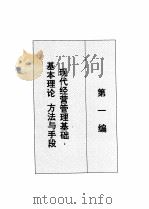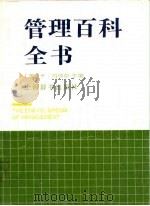《现代管理百科全书》
| 作者 | 马洪,孙尚清主编 编者 |
|---|---|
| 出版 | 北京:中国发展出版社 |
| 参考页数 | 2026 |
| 出版时间 | 1991(求助前请核对) 目录预览 |
| ISBN号 | 7800870081 — 求助条款 |
| PDF编号 | 87987348(仅供预览,未存储实际文件) |
| 求助格式 | 扫描PDF(若分多册发行,每次仅能受理1册) |

早期和古典管理理论2
国外古代管理思想(foreign ancient management thought)2
(early and classic management theory)2
目录2
国外中世纪管理思想(foreign mediaeval management thought)3
阿尔法拉比有关管理者品质的论述(Alfarabi on managers character)4
格扎里有关管理者品质的论述(Ghazali on managers character)4
帕西奥利簿记法(Paccioli bookkeeping)4
威尼斯商人的管理经验(managerial experiences of Venetian merchants)5
威尼斯兵工厂的管理经验(managerial experiences of Venetian arsenal)5
莫尔论管理的重要性(More on the importance of management)6
马基雅维利论管理方法(Machiavelli management methods)7
资本主义国家的企业管理思想(enterprise management thought in capitalist countries)8
资本主义早期的企业管理和控制(enterprise management and control of early capitalism)8
早期提出劳动分工的斯图亚特(Steuart early on division of labour)9
斯密论分工和控制(Smith on division of labour and control)9
阿克赖特的管理实践(managerial practice of Arkwright)10
李嘉图和群氓假设(Ricardo and the rabble hypothesis)10
索霍厂的早期科学管理(early scientific management in Soho Plant)10
欧文和新拉那克厂的管理(Owen and the management of New Lanark factory)11
法国制造业的早期科学管理(early scientific management in French manufactory)12
十八九世纪一些经济学家的管理思想(management thought of some economists in 18 and19 centuries)12
克劳塞维茨军事思想在管理中的应用(application of Clausewitz s military thought to man-agement)13
尤尔的有机系统(organic systems of Ure)14
早期管理教育家杜平(Dupin—early management educator)14
科学管理先驱者巴贝奇(Babbage—pioneer of scientific management)15
动作研究先驱者杰文斯(Jevans—pioneer of motion study)16
惠特尼的早期科学管理(early scientific management of Whitney)16
普尔的管理原则(Poor s management principles)17
麦卡勒姆的铁路管理经验(McCallum s management experiences in railway)17
汤的收益分享制(Towne s gain sharing system)18
梅特卡夫在兵工厂的科学管理(Metcalfe s scientific management in arsenal)18
哈尔西奖金方案(Halsey s premium plan)19
史密斯—泰罗的先驱者之一(Smith—a forerunner of Taylor)20
沃顿同最早的管理学院(Wharton and the first management college)20
科学管理理论(scientific management theory)21
西方古典管理理论(western classic management theory)21
标准化原则(principle of standardization)23
授权原则和部门化原则(principle of authorization and principle of departmentalization)24
第一流的工人(first class man)24
职能工长制(functional foremen)25
科学管理创始者泰罗(Taylor—father of scientific management)25
把数学应用于管理的巴恩(Barth applied mathematics to management)26
重视人的因素的甘特(Gantt paid attention to human factor)27
动作研究专家吉尔布雷思(Gilbreth—motion study expert)28
管理学第一夫人莉莲(Lillian—first lady of management)30
动作经济原则(principle of motion economy)30
灯光示迹影片(chronocyclegraph)31
疲劳研究(fatigue study)31
效率专家埃默森(Emerson—efficiency expert)32
科学管理应用专家库克(Cooke—expert of scientific management application)33
哈撒韦在泰伯厂对科学管理的应用(the application of scientific management at Tabor fac-tory by Hathaway)34
科学管理的宣传者布兰代斯(Brandeis—propagandist of scientific management)35
珀森和科学管理在学术界的推广(Person and the spread of scientific management in aca-demic circles)35
道奇在链带公司推广科学管理(the application of scientific management at Belt Company byDodge)36
法林和零售业科学管理(Filene and the scientific management in retailing)36
管理教育家金布尔(Kimball—management educator)37
汤普森和建筑业科学管理(Thompson and architectural scientific management)37
管理教材学者迪默(Diemer—management textbook writer)38
霍克西调查(Hoxie investigation)39
劳资关系专家瓦伦丁(Valentine—expert of labour relation)39
威廉斯和弹性预算(Williams and flexible budget)40
早期的办公室管理(early office scientific management)40
麦金西和管理的会计控制(Makinsey and the management control through accounting)41
诺普尔的盈亏转折图(breakeven chart by Knoeppel)41
美国早期的管理学教科书(early management textbooks in the US)42
福特制(Ford system)42
法国的古典管理理论(French classic management theory)43
一般管理理论首创者法约尔(Fayol—pioneer of general management theory)44
法国科学管理先驱者夏特里尔(Chatelier—pioneer of scientific management in France)45
科学管理在法国的宣传者弗雷门维尔(Freminville—scientific management propagandist inFrance)46
米什林公司的管理经验(management practice of Michelin Company)47
多特里的管理改革(management reform of Dautry)47
德国古典管理理论(German classic management theory)48
古典管理理论家韦伯(Weber—classic organization theorist)49
拉瑟瑙的管理理论和实践(management theory and practice of Rathenau)50
科特根和德国的合理化运动(Kottgen and the rationalization movement in Germany)51
………………………………………………………………………………………5l51
赫格纳和德国的工作研究(Hegner and work study in Germany)51
迈恩伯格的动作和工时研究(motion study and time study of Meyenberg)52
赫尔米希和德国的标准化运动(Hellmisch and the standardization movement in Germany)52
古典管理理论在英国等国的发展(the development of classic management theory in Englandand other countries)53
英国管理学家罗恩(English management scholar Rowan)53
刘易斯和工场管理(Lewis and factory management)54
赫福德等人的“工业管理纲要”(“Outline of Industrial Management”by Herford and others)55
约翰·李和“工业管理词典”(John Lee and the“Industrial Management Dictionary”)55
古典管理理论在奥地利(classic management theory in Austria)56
埃尔伯恩和管理职业(Elbourne and management as a profession)56
古典管理理论在瑞士(classic management theory in Swiss)57
比利时生产率运动先驱者索尔韦(Solvay—pioneer of productivity movement in Belgium)58
杰勒德和比利时的科学管理(Gerald and the scientific management in Belgium)58
古典管理理论在波兰(classic management theory in Poland)59
兰多尔和科学管理的应用(Landauer and the application of scientific management)59
古典管理理论在意大利(classic management theory in Italy)60
奥利佛拉和巴西全国科学管理学会(Oliveira and Brazilian National Society of ScientificManagement)61
里贝罗和科学管理在圣保罗的应用(Ribeiro and the application of scientific management inSaint Paul)62
科学管理在巴西的早期实行者西蒙森(Simonsen—early practioner of scientific manage-ment in Brazil)62
厄威克和古典管理理论的系统化(Urwick and the systemization of classic management theo-ry)63
古利克的管理理论(Gulick s management theory)64
古典管理理论的管理原则论(classic management theory on management principles)64
古典管理理论的管理职能论(classic management theory on management functions)65
组织设计和组织模型(organizational design and organizational models)66
一些奖金制(some premium plan)68
管理学者对古典管理理论的评价(evaluation of classic management theory by some man-agement theorists)69
销售研究(sale research)69
(theory of behaviour sciences)72
行为科学(behaviour sciences)72
行为科学理论72
福莱特——古典管理理论和行为科学之间的桥梁(Follett—a bridge between classic man-agement theory and behaviour sciences)73
利益结合原则(principle of integration)74
形势规律(law of situation)75
工业心理学创始人芒斯特伯格(Munsterberg—creator of industrial psychology)75
人事管理学家斯科特(Scott—scholar of personnel management)76
职业心理学家索利尔(Sollier—scholar of vocational psychology)77
英国工业心理学先驱迈尔斯(Myers—pioneer of industrial psychology)77
把工业心理学应用于管理的穆斯西奥(Muscio and the application of industrial psychologyto management)78
英国行为科学先驱者朗特里(Rowntree—pioneer of behaviour sciences in England)79
把人的因素和科学管理相结合的谢尔登(Sheldon integrated scientific management withhuman)81
重视人的企业家哈特内斯(Hartness——entrepreneur who pays attention to human)82
人事管理运动先驱者布卢姆菲尔德(Bloomfield—pioneer of personnel management move-ment)82
把心理学应用于工业的蒂德(Tead applied psychology to industry)83
职工咨询的先驱者巴布科克(Babcock—pioneer of employee consultation)83
重视职工积极性的丹尼森(Dennison paid attention to employee activeness)84
发展了甘特思想的克拉克(Clark developed the thought of Gantt)85
最优学的倡导者霍普夫(Hopf—initiator of optimization)85
美国管理协会的倡导者刘易森(Lewisohn—initiator of AMA)87
行为科学的奠基者梅奥(Mayo—founder of behaviour sciences)87
人际关系学说大师罗特利斯伯格(Roethlisberger—master of human relation theory)88
霍桑调查(Hawthorne investigations)89
社会人(social man)90
非正式组织(informal organization)91
职工满足度(employee s degree of satisfaction)93
人际关系学说(human relation theory)93
企业中人的特性的有关理论(theories of human nature in enterprises)96
组织行为学(organizational behaviour sciences)96
人类基本需要等级论(theory of human needs hierarchy)97
激励因素—保健因素理论(motivation—hygiene theory)99
生存、关系、发展理论(ERG theory)99
阿特金森的成就需要激励理论(Atkinson s theory of achievement motivation)101
成就需要理论(theory of achievement need)102
期望机率模式理论(theory of expectancy model)102
坎贝尔的期望机率模式(Cambell s model of expectancy)103
波特——劳勒期望机率理论(Porter—Lawler s theory of expectancy)105
公平理论(equity theory)106
归因理论(construct theory)106
强化理论(reinforcement theory)107
需要、动机和激励理论(theories of needs,motives and motivation)108
x理论—Y理论(X theory—Y theory)109
不成熟—成熟理论(theory of immaturity—maturity)111
有关人类特性的四种假设(four hypotheses of human nature)113
个体行为理论(theory of individual behaviour)114
团体行为理论(theory of group behaviour)116
组织行为理论(theory of organization behaviour)116
团体动力学(group dynamics)117
团体压力理论(group pressure theory)118
团体规范分析法(group rorm analysis method)118
团体内聚力(group cohesion)119
团体士气(group morale)120
信息交流的重要性及其误区(importance and erroneous zones of communication)121
信息交流的分类(classification of communication)122
正式信息交流网络(networks of formal communication)123
非正式信息交流渠道(channels of informal communication)123
信息交流效率的提高(raise communication efficiency)124
良好信息交流十诫(ten commandments of effective communication)124
社会关系计量学(sociometry)125
社会关系计量图表(sociogram)125
团体成员相互影响分析法(members inter-influences analysis method)126
团体竞争学说(group competition theory)127
团体冲突学说(group conflict theory)127
领导者品质理论(leaders character theory)128
领导方式双因素理论(two-dimensional model of leadership)128
管理方格法(managerial grid)129
支持关系理论(supportive relationship theory)130
团体目标—维持关系理论(group objective—supportive relationship theory)132
卢因的组织变革论(Lewin s organization change theory)132
卡斯特的组织变革论(Kast s organization change theory)133
沙恩的组织变革论(Schein s organization change theory)133
唐纳利的组织变革论(Donnelly s organization change theory)134
敏感性训练(sensitivity training)135
工作生活质量学说(working life quality theory)136
Z理论(Theory Z)137
企业文化(corporate culture)138
权变理论学派(contingency theory school)139
超Y理论(beyond theory Y)140
权变理论的思想结构(ideological structure of contingency theory)141
权变管理变数(variables of contingent management)142
权变变数的影响(influences of contingency variables)142
权变理论概念模式(conceptual model of contingency theory)144
计划制定的权变论(contingency planning theory)145
有目标的计划和指导性的计划(objective plan and directive plan)146
计划中的模糊性和灵活性(vagueness and flexibility in planning)146
伍德沃德的权变组织论(Woodward contingency organization theory)147
皮尤—希克森权变组织论(Pugh——Hickson contingency organization theory)148
劳伦斯—洛希权变组织论(Lawrence—Lorsch contingency organization theory)150
赫里格尔—斯洛坎姆权变组织论(Hellriegel—Slocum contingency organization theory)151
菲德勒权变领导模式(Fiedler contingency leadership model)151
菲德勒权变领导图表(Fiedler contingency leadership chart)152
雷定的三因素领导效率模式(Reddin three-dimensional leadership efficiency model)154
目标—途径领导理论(path—goal leadership theory)154
领导方式连续统一体理论(leadership continuum theory)156
领导—参与模式(leadership—participation model)157
领导生命周期理论(leadership life cycle theory〕158
唐纳利的领导模式(Donnelly leadership model)159
建议制度(suggestion system)159
作业加强(job intensification)160
管理价值模式(managerial value models)160
林肯计划和斯坎伦计划(Lincoln Plan and Scanlon Plan)160
解决问题的不同风格(different styles of problem-solving)161
工作满足(job satisfaction)161
心理合同学说(psychologic contract theory)161
当代管理理论164
(modern management theory)164
国外当代管理理论(foreign modern management theory)164
管理理论的丛林(management theories jungles)165
管理过程学派(management process school)167
组织效率三原则(three principles of organization efficiency)168
穆尼的管理理论(Mooney s management theory)169
戴维斯的“有机职能”论(Davis theory of organic functions )170
孔茨的管理职能论(Koontz s management function theory)171
健全组织工作原则(principles of sound organization work)172
孔茨论人事和指挥(Koontz on personnel and direction)173
控制职能的基本原则(basic principles of control)174
管理过程学派在美国的代表者丘奇(Church-representative of management process174
school in US)174
奥福德的管理学原则(Alford s principles of management)175
马丁德尔论管理评价标准(Martindell on management evaluation standard)176
布朗的管理三阶段论(Brown s theory of three management stages)176
纽曼的管理职能论(Newman s theory of management functions)177
特里论管理(Terry on management)177
管理职能表(management functions table)177
社会系统学派(social system school)178
杰出的管理学家巴纳德(Barnard-outstanding scholar of management)179
巴纳德的方法论(Barnard s methodology)180
作为协作系统的组织(organization as a cooperative system)181
组织的环境(organizations environment)182
个人与组织(individual and organization)183
巴纳德论正式组织和非正式组织(Barnard on formal and informal organizations)184
协作意愿(willingness to cooperative)184
组织的共同目标(common purpose of organization)185
信息联系七原则(seven principles of communication)186
经理人员三项职能(three functions of executives)188
经营管理与领导艺术(management and leadership art)189
决策理论学派(decision making school)191
组织决策网状结构(organization decision making network)192
决策过程四阶段(four stages of decision making)193
计划、审查同决策(planning,auditing and decision making)193
决策过程中的信息联系(communication in decision making)195
决策的准则和标准(norm and standard of decision making)195
决策的防范分析(preventive analysis of decision making)196
程序化决策和非程序化决策(programmed and unprogrammed decision making)197
程序化的决策技术(programmed decision making technique)198
非程序化的决策技术(unprogrammed decision making technique)199
决策中的思维过程(thinking process in decision making)200
决策和组织机构(decision making and organizational structure)200
决策同集权和分权(decision making and centralization and decentralization of power)201
决策者品质(characters of decision maker)202
价值判断和事实判断(value judge and fact judge)203
决策人模式(decision-maker model)204
决策和组织影响(decision making and organizational effect)204
系统理论(system theory)205
系统管理学派(system management school)205
系统观点(system approach)207
系统分析(system analysis)208
系统管理(system management)209
系统模型(system model)211
系统管理中的管理职能(management functions in system management)212
福莱斯特和工业动态学(Forrester and industrial dynamics)213
工业动态学的应用步骤(application steps of industrial dynamics)213
系统动态学(system dynamics)215
社会—技术系统学派(socio—technical system school)215
塔维斯托克研究所(Tavistock Institute)217
格拉西尔调查(Glacier investigations)218
社会系统与技术系统的关系(relationship between social system and technical system218
社会—技术系统中的管理等级制度(management hierarchy in socio-technical system)220
社会—技术系统与环境的关系(relationship between social-technical system and itsenvironment)221
环境因果结构(causal structure of environment)222
社会—技术系统的发展趋向(trend of social-technical system)224
社会—技术系统中的矩阵组织(matrix structure in socio-technical system)224
社会—技术系统理论的新应用(new application of social-technical system)225
经验主义学派(empirical school)226
德鲁克等论管理的性质(Drucker on the nature of management)227
管理的任务(management task)228
管理的职责(management duty)229
管理技能之一:作出有效决策(effective decision making)229
管理技能之二:有效地进行信息联系(effective communication)231
管理技能之三:正确地运用控制和衡量(correct control and evaluation)231
管理技能之四:正确运用分析工具—管理科学(correct analytic instrument—manag-232
ement science)232
目标管理(management by objective)233
目标管理的三个阶段(three stages of MBO)234
斯隆与事业部制(Sloan and division system)235
管理的组织结构(organizational structure of management)236
职能制组织结构(functional structure)237
矩阵组织结构(matrix structure)237
联邦分权制组织结构(Federal structure)238
模拟分权制组织结构(Simulated federal structure)239
高层管理的任务(task of top management)240
系统组织结构(system structure)240
高层管理的战略(strategy of top management)241
管理的比较研究法(comparative management research method)243
以比较为基础的一般管理原则(general management principles based on comparison)244
管理科学学派(management science school)245
管理科学的定义和目的(definition and objectives of management science)247
管理科学的特点(characteristics of management science)247
管理科学关于组织的看法(management science on organization)248
管理科学七步骤(seven steps of management science)248
管理科学的方法(methods of management science)250
计划评审法和关键线路法(PERT CPM)251
线性规划(linear programming)252
动态规划(dynamic programming)252
整数规划(integer programming)253
目标规划(objective programming)253
最优规划(optimal planning)254
运输方法(transportation method)254
马尔可夫分析(Markov analysis)255
排队论(waiting line theory)255
对策论(same theory)256
概率论(probability theory)256
模拟(simulation)256
一些调查分析法(investigation and analysis methods)257
安东尼模型(Anthony model)259
电子计算机在管理中的应用(application of computer to management)259
管理信息系统(MIS)260
生产信息与控制系统(COPICS)261
经理角色学派(managerial role school)262
经理工作六特点(six characteristics of managers work)263
经理角色图(managerial role chart)265
人际关系方面的角色(interpersonal roles)266
信息方面的角色(informational roles)267
决策方面的角色(decision making roles)268
经理的六项基本目标(six basic objectives of manager)269
影响经理工作的环境因素(environmental factors affecting managers duty)270
影响经理工作的职务因素(job s factors affecting managers duty)271
影响经理工作的个人因素和情景因素(personal factors situational factors affectingmanagers duty)272
经理职务的八种类型(eight types of managers job)273
提高经理工作效率十要点(ten essentials to raise managers efficiency)274
变动管理(change management)276
彼得原则(Peter s principle)276
七S管理模式(7S management model)277
七C管理模式(7C management model)278
十一C管理模式(11C management model)279
比较管理理论(comparative management theory)279
生态方法导向(ecological approach)280
行为科学方法导向(bchavioural approach)281
法默—里奇曼模式(Farmer-Richman model)283
瑞典的企业管理(enterprise management in Sweden)284
联邦德国的企业管理(enterprise management in Federal Germany)285
莱维特等论未来管理(Leavitt and others on future management)286
惠斯勒等论未来的组织和职能(Whisles and others on future organization and functions)287
卡斯特论未来的组织和环境(Kast and others on future organization and environment)288
管理经济学292
(managerial economics)292
管理经济学(managerial economics)292
机会成本(opportunity cost)293
经济利润、会计利润和正常利润(economic profit,accounting profit,normal profit)294
外显成本和内含成本(explicit cost,implicit cost)295
边际分析法(marginal analysis)295
利润理论(profit theory)296
需求量概念及其影响因素(the concept of quantity demanded and the determinants297
of demand)297
需求函数(demand function)298
需求曲线(demand curve)299
需求规律(law of demand)300
需求的变动和需求量的变动(change in demand,change in quantity demanded)300
供给量概念及其影响因素(the concept of quantity supplied and the determinants ofsupply)302
供给函数和供给曲线(supply function,supply curve)302
供给规律(law of supply)303
供给的变动和供给量的变动(change in supply,change in quantities supplied)303
供求法则(the laws of demand and supply)304
需求-供给分析法(the demand-supply analysis)306
蛛网定理(cobweb theorem)307
需求弹性及其种类(demand elasticity and its classification)308
价格弹性的概念及其计算(the concept of price elasticity and its calculation)309
价格弹性与销售收入之间的关系(relationship between price elasticity and revenue)311
需求曲线按价格弹性大小分类(classification of demand curve in terms of price elasticity)312
影响价格弹性的因素(factors influencing price elasticity)313
需求的收入弹性(income elasticity of demand)313
需求的交叉弹性(cross elasticity of demand)314
需求的估计与预测:数据来源(demand estimation and forecasting:sources of data)315
需求的估计与预测:趋势推测(demand estimation and forecasting:trend projection)316
需求的估计与预测:计量经济学方法(demand estimation and forecasting:econometricmethods)318
生产函数(production function)321
单一可变投入要素的最优利用(optional level of single variable input)322
总产量、平均产量和边际产量的相互关系(relationships among the total,average andmarginal product)323
边际收益递减规律(law of diminishing returns)325
生产的三个阶段(the three stages of production)325
等产量曲线(equal-product curve)326
等成本曲线(isocost curves)329
多种投入要素最优组合的确定(determination of optional combinations of multiple inputs)330
价格变动对投入要素最优组合的影响(the effect of change in factor price on the332
optional combination of inputs)332
生产扩大路线(the expansion path)333
规模收益及其类型(return to scale and its classification)333
规模的经济性和不经济性(economies and diseconomies of scale)334
规模收益类型的判定(testing production functions for returns to scale)335
技术进步的测定(measurement of technological change)335
产品产量最优组合决策的理论(decisions regarding optimal output combination:Theory)336
产品产量最优组合决策的实践(decisions regarding optimal output combination:Practice)338
增量成本和沉没成本(incremental cost and sunk cost)340
成本函数与生产函数之间的相互关系(the relationship between cost and production340
functions)340
短期成本函数(short-run cost functions)341
长期成本函数(long-run cost function)344
收入函数(revenue function)346
贡献分析法(contribution analysis)348
线性盈亏分界点分析法(linear break-even anaiysis)349
多产品盈亏分界点分析法(multi-product break-even analysis)351
经营杠杆(operating leverage)352
短期成本的估计(short-run cost estimation)353
长期成本的估计(long-run cost estimation)356
学习曲线(learning curves)357
市场结构及其类型(market structure and its classifications)359
完全竞争条件下企业的短期产量决策(short-run output decision under perfect compet-ition)360
完全竞争条件下企业的停业条件(the firm s shut-down point under perfect competition)361
完全竞争条件下企业的长期均衡(long-run equilibrium of firms under perfect compet-ition)361
competition)363
完全竞争条件下行业的长期供给曲线(long-run industry supply curve under perfect363
企业的短期供给曲线(short-run supply curve of firms)363
供给弹性(elasticity of supply)365
对完全竞争市场结构的评价(evaluating market structure of perfect competition)365
完全垄断条件下企业的价格和产量决策(the firm s price/output decision under366
perfect monopoly)366
对自然垄断企业的价格管制(price regulation of natural monopoly firm)367
对完全垄断市场结构的评价(evaluating market structure of perfect monopoly)368
垄断性竞争条件下企业的价格和产量决策(the firm s price/output decision under368
monopolistic competition)368
垄断性竞争条件下企业的长期均衡(the firm s long-run equilibrium under monop-369
olistic competition)369
对垄断性竞争市场结构的评价(evaluating market structure of monopolistic competition)370
寡头垄断条件下企业的价格和产量决策:曲折的需求曲线模式(the firm s price/371
output decisions under oligopoly:kinked demand curve model)371
寡头垄断条件下企业的价格和产量决策:价格领导模式(firm s price/output decision372
under oligopoly:Price leadership)372
寡头垄断条件下企业的价格和产量决策:博弈论模式(firm s price/output decision372
under oligopoly:Game theory model)372
卡特尔(cartel)373
非价格竞争(nonprice competition)374
企业行为的销售收入最大化模式(the revenue maximization model of business behavior)375
成本加成定价法(cost-plus pricing)377
增量分析定价法(incremental analysis in pricing)378
差别定价法(price discrimination)379
多产品定价:需求上有关联性的产品(multiple-product pricing:products with demandinterrelationships)381
多产品定价:生产上有关联性的产品(multiple-product pricing:products with productioninterrelationships)382
新产品定价法(new product pricing)383
调拨价格的确定(transfer pricing)385
确定最优报价的原理与实践(the principles and practices of determining the optimalbid price)387
广告和销售量之间的函数关系(the advertising-sales relationship)390
价格不变的情况下确定最优的广告费支出(the optimal level of advertising for a391
given price level)391
adjustment of price and advertising level)392
把广告当作投资进行决策(decision of advertising as an investment)392
价格和广告费可以同时调整的条件下的广告决策(advertising decision:simultaneous392
投资的概念及其决策步骤(the concept of investment and procedures of investment393
decisions)393
净现金投资量(net cash investment)394
净现金效益量(net cash benefits)395
最优投资规模的确定(determining optimal investment scale)396
内部利润率法与返本法比较(comparison of IRR and payback methods)396
净现值法和内部利润率法比较(comparison of NPV and IRR methods)397
对寿命不同的投资方案的评价(evaluation of investment projects with unequal lffes)398
有风险条件下的投资决策(investment decisions under risky conditions)399
美国企业兼并的四次高潮(four merger waves in USA)403
兼并的分类及其经济效益分析(classifications of merger and their economic effects)405
美国企业兼并的动机(motives of mergers in USA)407
美国企业兼并的方式(types of mergers in USA)408
投资银行在兼并中的作用(the role of investment banks in mergers)408
被收购企业价格的确定(determining the price paid for an acquired firm)409
(strategic management)412
战略管理(strategic management)412
战略管理412
战略制定(strategy fomulation)413
环境分析(environmental analysis)413
企业宏观环境(macroenvironment)414
行业环境(industry environments)415
竞争情况(competitive situation)416
跨国公司环境(multinational firms environments)417
利益集团分析(stakeholder analysis)418
企业内部评估(internal appraisal)418
战略问题管理(strategic issue management)419
环境预测(environmental forecasting)420
目标制定(cbjective formulation)421
企业使命(corporate mission)422
企业社会职责(social responsibilities)423
战略目标(strategic objectives)424
长期目标(long-term objectives)424
战略层次(levels of strategy)425
战略决定因素(determinants of strategy)426
战略形成过程(strategy formation process)427
公司战略(corporate strategies)428
集中型增长战略(concentric growth strategies)429
创新战略(innovation strategies)430
一体化发展战略(integrative growth strategies)431
多种经营战略(diversification growth strategy)432
进入新经营领域战略(strategies for entering new business)433
转变、紧缩、全面改组战略(corporate turnaround,retrenchment and portfolio restruct-uring strategies)434
放弃、分离、清理战略(abandonment,divestiture,and liquidation strategies)435
兼并战略(merger strategies)436
复合战略(combination strategies)437
适应战略(fitting strategy to a firm s situation)437
跨国公司战略(transnational corporation strategies)438
小企业战略(strategies for small companies)439
经营单位战略(business-level strategies)440
低成本战略(striving to be the low-cost producer)441
差异化战略(strategy of differentiation)442
集中与专业化战略(focus and specialisation strategies)443
领导型企业竞争战略(competitive strategies for leaders and dominant firms)444
优胜企业竞争战略(competitive strategies for runner-up firms)445
危难企业转变战略(turnaround strategies for distressed business)446
平庸与衰退企业竞争战略(competitive strategies for also-ran and declining firms)446
新兴行业中的竞争战略(strategies for competing in young emerging industries)447
向成熟期转变行业中的竞争战略(strategies for competing during the transition to448
industry maturity)448
衰退行业中的竞争战略(competitive strategies in declining industries)449
散碎行业中的竞争战略(strategies for competing in fragmented industries)450
全球性行业中的竞争战略(strategies for competing in global industries)452
进攻战略(offensive strategies)453
防守战略(defensive strategies)454
战略分析和选择(strategic analysis and choice)454
波士顿矩阵(the BCG growth share matrix)455
GE矩阵(the General Electric matrix)456
产品/市场演变矩阵(the product/market evolution matrix)457
产品/使命矩阵(the product/mission matrix)458
多种经营矩阵(diversification matrix)459
寿命周期分析(life cycle analysis)459
关键成功因素分析(critical success factor analysis)460
SWOT分析(SWOT analysis)461
战略选择矩阵(grand strategy selection matrix)462
战略聚类模型(model of grand strategy clusters)462
影响战略选择的行为因素(behavioral considerations affecting strategic choice)463
战略实施(strategy implementation)464
年度目标(annual objectives)465
职能战略制定(Functional strategy formulation)466
企业方针(policies)467
战略计划(strategic planning)467
战略与组织结构(strategy and structure)468
组织结构类型(types of organizational structure)469
组织基本协调机制(basic coordinating mechanisms)471
组织设计理论(theories of organization design)472
战略与资源分配(strategy and resources allocadon)473
战略与组织领导(strategy and organizational leadership)475
董事会的战略职责(strategic functions of the board of directors)476
企业计划人员的战略管理作用(role of corporate planner in strategic management)477
高层经理的战略管理职责(top managers strategic function)477
战略与组织文化(strategy and organizational culture)478
战略控制与评价(controlling and evaluating the strategy)479
控制系统(control systems)480
战略控制(strategic control)481
业务控制(operational control)481
企业绩效监控与偏差评价(monitoring performance and evaluating deviations)482
激励性控制与评价(motivating control and evaluation)483
变革战略(strategy for managing change)485
预算与战略实施(budgeting and strategy implementation)485
战略决策(strategic decisions)486
影响决策的社会心理因素(social and psychological factors)487
外部权力关系(external power relationships)487
内部权力关系(internal power relationships)488
公司计划(corporate planning)489
渐进模式(incremental models)490
混合扫描(mixed scanning)490
逻辑渐进主义(logical incrementalism)491
经营者增量模式(a managerial incremental model)491
良好实践模式(good practice model)492
决策过程模式(decision process models)493
战略决策权变理论(contingency theory of strategic decision making)494
战略管理信息的搜集(finding strategic management information)495
战略计划的信息系统支持(information system support for strategic planning)496
战略管理关键信息判断(identifying critical information for strategic management)497
决策支持系统在战略管理中的应用(decision support system for strategic management)498
非营利组织战略管理(strategic management of not-for-profit organizations)499
战略管理未来趋势(future of strategic management)500
生产管理职能(functions of production management)502
(production management)502
生产管理502
生产管理发展史(history of production management)503
生产管理组织机构(organizationas of production management)505
工业工程(industrial engineering)507
生产管理决策(decision-making of production management)508
生产投资决策(decision-making of production investment)509
生产品种决策(decision-making of production variety)511
生产管理诊断(consultation of production management)512
厂址选择(plant location)513
工厂布置(plant layout)514
车间布置(workshop layout)515
相关图布置法(layout method by correlation chart)515
物料流向图布置法(layout by material flow chart)517
零件从至表布置法(layout method by from-to chart)518
分等加权厂址选择法(plant location by grading)520
CRAFT法(computerized relative allocation of facilities tecinique)521
生产过程(production process)522
生产类型(types of production)523
工序(operation)523
工艺原则布置(principles of organization by process)524
对象原则布置(principles of organization by product)524
流水生产(flow production)525
工序平衡(operation balancing)526
单一品种流水线设计(designing assembly line of single variety)528
多品种流水线设计(designing assembly line of multi-variety)529
厂内运输(in-plant transport)530
成组技术(group technology)531
奥匹兹系统(Opitz s system)532
成组生产作业计划(operation schedule of production by GT)533
成组生产组织(organization of production by GT)533
自动生产线(automated production line)534
机器人(robot)534
计算机辅助生产(computer-aided production)535
人机系统(system of man-machine)536
方法研究(method study)536
生产过程分析(analysis of production process)537
人—机联合分析(analysis of man-machine)540
5W1H法(method of 5W1H)541
搬运分析(transport analysis)542
动作研究(motion study)542
动作经济性原则(principles of motion economically)543
作业测定(work measurement)544
测时(time measuring)545
工作抽样法(work sampling)549
预定时间法(predetermined time standard)553
德意志联邦共和国参与决定法(Participation and Decision Act of FRG) 1553
工时消耗结构(classification of man-hour consumption)561
生产总体计划(aggregate production plan)562
订货加工生产进度计划(order production scheduling)564
大型工程项目进度计划(large project scheduling)566
大量生产的生产进度计划(mass production operation schedule)566
生产能力计划(plan of production capacity)569
订单管理(order management)570
平衡线法(line of balance)570
网络计划方法(program evaluation and review technique)573
作业控制(operation schedule control)576
甘特图(Gantt chart)577
物资需要量计划(material requirements planning)578
运筹学在生产管理中的应用(application of operations research to production manage-ment)579
线性规划在生产管理中的应用(application of linear programming to production581
management)581
排队论在生产管理中的应用(application of queuing theory to production management)582
生产日历标准(standard of production scheduling)583
生产批量(batch size of production)584
生产周期(production cycle)586
生产提前期(lead time of production)587
任务命令单(work sheet)588
故障模型、影响及其严重性分析(failure mode,effect,and criticality analysis;FMECA)看板管理(card control)589
生产排程(arrangement of operating sequence)590
生产作业准备(pre-operation work)590
价值工程(value engineering)592
迈尔斯十三原则(Miles s 13 principles)593
功能分析(function analysis)594
功能评价(function evaluation)595
设备管理(equipment management)597
设备综合工程学(terotechnology)597
设备磨损规律(law of wear and tear)597
设备维护与修理(equipment maintenance)598
全员生产维修(total productive maintenance)599
设备改造与更新(equipment upgrading and renewal)601
备件管理(spare parts management)602
设备计划预修制(equipment planning preventive maintenance system)602
无形磨损(obsolescence)603
快速折旧(accelerated depreciation)604
环境管理(environmental management)606
安全管理(industrial safety)607
能源管理(energy management)609
“五S”管理( 5S management)610
定置管理(fixed position management)610
工效学(ergonomics)613
“一个流”生产方式(one-flow production style)614
物流管理(physical distribution management)615
现场管理(workshop management)617
柔性制造系统(flexible manufacturing system,FMS)619
质量管理622
(quality management)622
质量(quality)622
提高质量的意义:社会方面(significance of improving quality:social aspect)623
提高质量的意义:经济方面(significance of improving quality:economical aspect)624
提高质量的意义:国际方面(significance of improving quality:international aspect)624
质量管理学的形成与发展(the establishment and development of the quality management)626
质量管理的四项基本工作(four jobs of quality control)628
质量管理“三部曲”(the trilogy of quality management)629
宏观质量管理与微观质量管理(macroquality management and microquality management)630
影响产品(或服务)质量的9M因素(the 9M s:fundamental factors affecting quality)631
管理可控差错与工人可控的差错(management-controllable errors and operator-631
保护消费者利益(consumerism)632
产品责任(product liability)634
全面质量管理的含义与要求(the meaning and scope of total quality control)635
全面质量管理在企业中的地位与作用(the place of TQC in the modern business636
management)636
质量职能(quality function)638
质量特性(quality characteristic)639
质量标准(quality standard)640
质量控制(quality control)641
质量保证(quality assurance)642
质量方针(quality policy)644
质量目标(quality objective)645
质量计划工作(planning for quality)647
标准化与质量管理(standardization and quality management)648
ISO-9000,9001,9002,9003,9004“质量管理和质量保证”国际标准(quality manage-649
ment and quality assurance international standard)649
质量体系(quality system)650
质量手册(quality manual)651
质量审核(quality audit)652
质量管理文件的收集、利用和保存(collection,application and storage of quality docu-mentation)653
质量管理中的统计方法(statistical technology of quality control)654
PDCA循环(PDCA circle)655
日本质量管理中的“老七种工具”(“old seven tools”in Japan quality control)657
日本质量管理中的“新七种工具”(“new seven tools”in Japan quality control)658
帕累托分析(Pareto analysis)660
因果图分析法(cause and effect diagrams)662
试验设计(design of experiments)663
调优运算(evolutionary operation)665
响应面方法(response surface methodology)666
三次设计(Taguchi methods)668
回归分析(regression analysis)670
假设检验(test of hypothesis)671
新设计控制(new-design control)672
质量的市场研究:组织、目标、计划与方式(quality-oriented market research:organiz-ation,objectives,plan and patterns)674
设计质量(quality of design)675
可靠性设计与管理(design and control of product reliability)676
产品安全性设计与管理(design and control of product safety)679
价值工程(value engineering)682
可维修性(maintainability)684
产品使用寿命周期费用(life cycle and use-oriented quality cost)685
进厂材料控制(incoming-material control)686
抽样检验(acceptance sampling)688
抽样特性曲线:生产者风险与消费者风险(operating characteristic curve:producer s riskand consumer s risk)689
计数标准型抽样检验(acceptance sampling:attribute)692
(美国)军用标准105D抽样表(military standard 105D sampling tables)693
连续型抽样方案(continuous sampling plans)697
(美国)军用标准414抽样表(military standard 414 acceptance sampling tables:variables)698
散货抽样验收(bulk material acceptance sampling)702
供应商资格评审(vendor qualification review)706
供应商评级(vendor ratings)707
供需双方的联合计划(joint planning for vendor and purchaser)709
产品控制(product control)710
4M1E——影响工序质量的因素(4M1E——factors affecting process quality)711
工序质量波动性分析(process-variation analysis)712
工序能力的分析及工序能力指数计算(process capability analysis and measurement)713
控制图:?714—R、p、c(control chart:?715—R,p,c)714
产品检验:合格性判断与适用性判断(product inspection:the conformance decision andthe fitness for use decision)715
破坏性检验与非破坏性检验(destructive inspection and undestructive inspection)717
检验计划与质量检验(inspection planning and quality inspection)717
感官检验(sensory tests)718
质量缺陷严重性分级(quality defects seriousness classification)719
检验人员的误差及分析(inspector s errors and its analysis)720
计量基准与手段(criterion and means of measurement)722
计量误差及其分析(measure deviation and its analysis)723
校准工作的控制(calibration control)724
可追查性(traceableness)725
质量信息体系(quality information system)726
售后服务质量(post-sale service quality,or post-production quality service)726
产品包装、运输和储存的质量控制(quality control of packaging,transportation andstorage)727
顾客投诉的分析与处理(analysis and handling of customer complaints)729
质量改进十四步(14 steps to quality improvement)730
质量许诺(quality commitment)731
controllable errors)733
急性质量故障与慢性质量故障(sporadic and chronic quality troubles)734
质量突破及其步骤(quality breakthrough and it s universal sequence)735
质量教育与培训(quality education and training)736
质量意识及自我评定(quality consciousness and self-evaluation)738
质量经理的职责和作用(the role and responsibilities of quality manager)741
现场生产人员的职责和作用(the shop operator and supervisor s responsibilities inquality control)742
质量管理机构的组织(organizing for quality organization)742
无缺陷规划(zero defect program)744
质量管理小组(QC小组)(quality control circle)746
萨拉托夫制(Saratov system)748
多罗制(Doro system)749
质量成本(quality cost)750
质量成本的分析、研究(quality cost analysis)751
通过成本优化改进质量(quality improvement through cost optimization,QUICO)753
质量管理在第三产业中的应用(applying quality management in the tertiary industry)754
医院医疗差错的控制(error control in hospitals)755
电话服务的质量控制(quality control in telecommunications)757
饭店质量控制(quality control in hotel)758
运输业的质量控制(quality control in transport industry)759
工业发达国家质量管理的共性与个性:美国、日本、西欧、苏联、东欧(general and760
specific character of quality management in developed countries:U.S,Japan,WestEurope,Soviet Union,East Europe)760
跨国公司质量管理的“6c”要求(6c s requirements of quality control in a multinationalcompany)761
跨国公司质量管理的组织原则(principles of organizing quality control in a multin-ational company)762
市场营销764
(marketing)764
市场营销(marketing)764
需求状态与市场营销任务(various states of demand and the corresponding marketingtasks)765
市场经营观念(marketing concept)767
市场营销系统(marketing system)768
市场营销管理(marketing management)770
市场机会(market opportunity)770
市场机会数量分析(quantitative analysis of market opportunity)771
买方市场与卖方市场(buyer s market and seller s market)772
市场(market)772
消费者行为(consumer behaviour)773
企业生存理论(theory of company surviving and prospering)775
消费者购买行为类型(types of consumer s buying behaviour)776
购买决策过程(buying decision process)777
消费者评估模型(evaluation models of consumer decision)778
消费者满意度(satiability of consumer needs)780
工业品市场的购买行为(buying behaviour in industrial market)780
政府市场的购买行为(buying behaviour of the government market)782
市场细分化(market segmentation)782
市场细分化的基础(bases for market segmentation)783
目标市场(target market)784
策略性规划程序(the strategic planning process)785
市场营销环境:微观环境(marketing environment:microenvironment)787
市场营销环境:宏观环境(marketing environment:macroenvironment)788
产品(product)789
产品线(product line)790
产品组合(product mix)791
劳务品与其决策(service-product and its decisions)792
新产品开发(development of new product)792
新产品开发诸阶段(stages of the new product development process)793
消费者行为与新产品(consumer behaviour and new products)795
产品生命周期(product life cycle)795
家庭生命周期(family life cycle)797
包装(packaging)798
厂牌和厂牌决策(brand and brand decisions)798
定价方法(pricing method)799
价格调整策略(price modification strategies)801
边际成本和边际收益(marginal cost and marginal revenue)803
需求弹性(elasticity of demand)804
销售促进(sales promotion)806
促销组合(promotion mix)806
广告(advertising)808
广告媒体与媒体选择(advertising media and its choice)809
广告的管理环境(the regulatory environment of advertising)810
公共关系(public relations)811
销售渠道(channel of distribution)812
市场营销功用与市场营销流(marketing functions and flows)813
零售(retailing)814
零售管理的战略决策(strategic retail management decisions)815
批发(wholesaling)815
批发管理的战略决策(stategic wholesale management decisions)816
超级市场(supermarkets)817
购物中心(shopping centers)817
邮购商店(mail-order houses)818
折扣商店(discount stores)819
连锁商店(chain stores)819
日本企业经营管理现代化的标志(indices of the modernization of business managementand administration in Japan) i820
百货商店(department store)820
期货市场(futures markets)820
代理(agents)823
销售渠道管理(management of distribution channel)823
销售渠道修正决策(decision of distribution channel modification)825
实体分配(physical distribution)826
零售业的轮式循环(wheel of retailing)828
销售管理(sales management)828
销售力量规划(planning of sales force)830
销售力量管理(management of sales force)831
人员推销(personal selling)833
人员销售的原则(principies of personal selling)834
营销中介(marketing intermediaries)835
垂直销售系统(vertical marketing systems)835
横向销售系统(horizontal marketing systems)836
多渠道销售系统(multi-channel systems of distribution)836
市场调研(marketing research)837
市场营销信息系统(marketing information system)838
市场预测(forecasting future market)839
市场营销中的决策(decision-making in marketing)840
市场评价(measuring and estimating market)840
战略规划(strategic planning)841
市场营销规划(marketing planning)842
市场营销监控(marketing control)843
战略监控(strategic control)844
盈利性监控(profitability control)844
市场营销部门的演化(evolution of marketing department)845
市场营销道德规范(marketing ethics)846
市场营销对消费者福利的影响(affects of marketing on welfare of consumers)846
市场营销对社会的影响(affects of marketing on society)847
消费者主义(consumerism)848
服务产品营销(services marketing)849
非赢利机构的市场营销(marketing in nonprofit organizations)850
事业性市场营销(cause-related marketing)850
国际市场营销(international marketing)851
材料、物料、物资(materials,supplies,means of production)854
材料管理(materials management或logistics management)854
(materials management)854
材料管理854
物流、商流、信息流(materials flow,business flow,information flow)855
材料管理职能(functions of materials management)856
材料管理组织(materials management organization)857
配送、配送中心(distribution,distribution center)858
材料管理人员的培训与资格考核(education and training of materials staff and the859
qualifying examination)859
材料管理与企业规划(materials management and corporate planning)860
材料管理与企业经营环境(materials management and corporate environmental influen-ces)862
材料的分类与编号(classification and symbolization of materials)863
日本企业的资材管理(materials and equipments management in Japanese company)864
苏联企业的物资技术供应(organization s materials and technical equipment866
supply in U.S.S.R.)866
采购(purchasing)866
采购组织(purchasing organization)867
采购部门的职责(duties of purchasing department)868
采购部门与其它业务部门的关系(purchasing vis-à-vis other departments)868
采购政策(purchasing policies)869
采购市场调查(study of supply markets)871
采购预算(purchase budget)871
采购计划(purchasing planning)872
采购方法(purchase method)872
材料采购与价值分析(purchasing and value analysis)872
材料采购的质量保证(purchase quality assurance)873
采购程序(purchasing process)874
供应厂商的选择(selection of the right suppliers)876
谈判(negotiation)878
购货合同(purchase contract)879
废旧和剩余材料处理(disposal of scrap and surplus)880
采购记录(purchasing department record)881
采购绩效评价(measuring purchasing performance)881
库存及其分类(inventory and its classification)882
库存控制(inventory control)883
库存的功能(functions of inventory)883
库存管理系统(inventory management system)884
定量(定点)库存控制系统(fixed order quantity system)884
库存论(inventory theory)885
定期库存控制系统(fixed order interval system)885
库存模型及其类型(inventory models and types of inventory models)886
独立性需求量预测(forecasting independent demand)886
存货成本(费用)(inventory costs)888
经济订货批量库存控制模型(classic economic order quantity model,简称EOQ model)889
EOQ模型的敏感性分析(sensitivity analysis of EOQ model)890
允许缺货延期付货的确定型定量库存控制模型(EOQ model with planned shortages891
and back orders)891
允许缺货失去销售的确定型定量库存控制模型(EOQ model with planned shortages892
and lost sales)892
连续进货连续消耗不允许缺货的确定型定量库存控制模型(EOQ model with uniform893
replenishment rate,no shortages permitted)893
连续进货连续消耗允许缺货的确定型定量库存控制模型(EOQ model with uniform893
replenishment rate,shortages permitted)893
价格有折扣的确定型定量库存控制模型(EOQ model with quantity discounts)894
有约束条件(仓库容积、资金等)的确定型定量库存控制模型(EOQ model with res-896
ource constraints,such as storage space and working capital restrictions)896
多种物料联合订购的确定型定量库存控制模型(EOQ model for multiple items)897
随机型定量库存控制模型(stochastic inventory models in the fixed order quantity system)897
次性订货量随机型库存控制模型(single order quantity model with stochastic demands)900
确定型定期(经济订货间隔期)库存控制模型(deterministic economic order interval901
model,简称EOI model)901
随机型定期库存控制模型(stochastic economic order interval model)902
库存模拟(inventory control simulation)904
A、B、C分类库存管理法(ABC classification system in inventory control)904
库存记录(inventory records)905
存货计价方法(methods of inventory valuation)905
零库存管理制度(zero inventory system)905
仓库(warehouse)906
自动化立体仓库(high bay automated store)907
库内布局(store layout)908
仓库进货与发货(receiving and dispatching of materials)909
物料储存(storing of materials)910
条型码(identifying code with stripes)911
包装(packing)913
货架(shelves and racks)914
托盘(pallets)915
集装箱(containers)917
集装袋(flexible containers)918
货物分拣(order-picking)919
物料搬运系统(materials handling system)920
巷道式堆垛起重机(stacker crane for aisle operation)921
自动导向搬运车(automated self-controlled truck)921
仓库环境监控报警系统(store environmental monitoring system)923
仓库自动报警灭火系统(store automated fire alarming and extinguishing system)923
(financial management and accounting control)926
财务管理(financial management)926
财务管理与会计控制926
西方财务管理的发展(the evolution of western financial management)927
财务管理的目标(target of financial management)927
财务管理的组织结构(organizational structure of financial management)928
财务管理的金融环境(financial environment of financial management)929
财务管理的经济环境(economic environment of financial management)930
财务管理的法律环境(legal environment of financial management)931
货币的时间价值(time value of money)933
证券投资组合的风险(risk of securities investment combination)934
资本结构理论(theory of capital structure)935
财务分析(financial analysis)936
比率分析(ratio analysis)937
趋势分析(trend analysis)938
财务预测(financial forecasting)939
财务需求预测(forecasting financial requirement)940
财务预算(financial budgeting)941
现金预算(cash budgeting)942
资金来源(sources of funds)943
商业信用(trade credit)944
商业票据(commercial paper)945
短期银行贷款(short-term bank loans)946
应收帐款代理(factoring receivables)946
筹资组合(financing mix)947
现金管理(cash management)948
现金收支管理(the management of cash collection and disbursement)949
最佳现金余额(optimum cash balance)950
有价证券管理(marketable securities management)951
应收帐款管理(accounts receivable management)952
长期投资(long-terms investment)953
现金流量(cash flows)955
投资决策指标(investment decision criteria)956
股票发行(stock issue)957
股票交易(stock deals)958
股票价格(stock price)959
优先股融资(preferred stock financing)960
财务杠杆(financial leverage)962
股利支付程序(dividend payment procedure)963
股利政策(dividend policy)963
影响股利政策的因素(the elements of affecting dividend policy)964
认股权(right offering)966
债券评估(valuation of debenture)967
公司债券及其种类(bonds and types of bonds)968
股利理论(dividend theory)969
可转换债券(convertible bonds)970
租赁融资(lease financing)971
股票购回(repurchase of stock)972
普通股与公司债的比较(contrast of bond and common stock)973
股票分割(stock split-up)974
公司债券的构成要素(elements of bonds)974
总资本成本率(overall cost of capital)975
留存盈余成本率(cost of retained earnings)976
优先股成本率(cost of preferred stock)976
普通股成本率(cost of equity capital)976
借款融资(debt loan financing)977
债务成本率(cost of debt)978
资本成本(capital cost)979
破产与重整的财务管理(financial management of bankruptcy and reorganization)979
通货膨胀对财务管理的影响(the impact of inflation on financial management)980
通货膨胀条件下的长期投资管理(long-terms investment on inflation)982
国际财务管(international finance management)983
资产评估(assets appraisal)985
资产评估的原则(principles of assets appraisal)986
资产评估的种类和基本方法(styles and principal methods of assets appraisal)987
资产评估的程序(procedure of assets appraisal)988
资产评估的成本法(cost method of assets appraisal)989
资产评估的收益法和市场法(income methods and market methods of assets appraisal)990
有价证券的评估方法(methods of securities appraisal)991
无形资产的评估方法(methods of intangible assets appraisal)992
会计(accounting)993
财务会计(financial accounting)994
会计目标(objective of accounting)995
会计假设(accounting postulates,accounting assumptions)996
会计要素(accounting elements)997
会计原则(accounting principles)998
会计程序(accounting procedures)999
现金(cash)1000
应收帐款(accounts receivable)1001
存货(inventory)1002
投资(investment)1003
固定资产(fixed assets)1004
固定资产折旧(depreciation of fixed assets)1005
无形资产(intangible fixed assets)1006
流动负债(liquid liabilities)1007
长期负债(long-term liabilities)1007
股东权益(stockholder s equity)1008
收益表和留成收益表(income statement and statement of retained earnings)1009
资产负债表(balance sheet)1010
财务状况变动表(statement of changes in financial position)1011
财务报表的分析(analysis of financial statement)1012
成本会计(cost accounting)1013
合并财务报表(consolidated financial statement)1013
生产成本(manufacturing cost)1014
分批成本计算法(job-order costing)1015
分步成本计算法(process costing)1015
管理会计(management accounting)1016
成本性态分析(cost behavior analysis)1017
变动成本法(variable costing)1018
本量利分析(cost-volume-profit analysis)1019
短期决策的分析(short-term decision analysis)1020
长期投资决策分析(long-term investment decision analysis)1021
标准成本系统(standard cost system)1022
责任会计(responsibility accounting)1023
人力资源会计(human resource accounting)1024
物价变动会计(price changing accounting)1024
内部控制制度(internal control system)1025
审计(auditing)1025
人力资源(human resouces)1028
(human resources management and development)1028
人力资源管理与开发1028
人力资源管理(human resouce management)1029
人事管理的发展(personnel management development)1031
人力资源开发(human resouce development)1031
人力资源管理者和组织(human resource manager and organization)1034
人力资源管理的模型(model of human resource management)1036
人力资源管理的环境(environment of human resource management)1037
人力资源管理与效率(human resource management and efficiency)1037
人事管理的专业化(professional personnel management)1038
人力资源管理的发展趋势(perspective of human resource management)1039
国际性人力资源管理(international human resource management)1040
人事研究(personnel research)1040
职务设计(job design)1041
职务分析(job analysis)1042
指导定向职务分析(guideline-oriented job analysis)1043
职务说明(job description)1043
生理素质分析(physical ability analysis)1044
工作职能分析(functional job analysis)1044
职位与职位分类(position and positional classification)1045
职位分类的结构(structures of position classification)1046
职位分类与品位分类(position classification and rank classification)1046
职位分类的功能(functions of position classification)1049
职位分类的原则、标准、步骤与方法(principles,criteria,steps and methods of positionclassification)1050
职位分类的优越性(superiorities of position classification)1050
美国的职位分类(American position classification)1051
工作面谈法(Hay plan)1054
管理职务描述问卷(management position questionnaire)1054
职位分析问卷(position analysis questionnaire)1054
关键事件技术(critical incident technique)1055
方法分析(method analysis)1055
人力资源规划(human resource planning)1056
任务清单法(task inventories)1056
扩展关键事件技术(extended critical incident technique)1056
职业生涯(career)1058
职业生涯的设计和规划(career planning)1059
职业生涯管理(career management)1060
研究职业生涯设计与开发的意义(significance of the study of career planning and1062
development)1062
职业生涯的选择(career choices)1062
职业生涯的阶段(career stages)1064
职业生涯规划信息系统(career planning information system)1066
职业生涯管理信息系统(career management information system)1066
人员招聘(personnel recruitment)1068
招聘程序(recruiting procedure)1069
招聘战略(recruiting strategy)1070
招聘广告(recruiting advertisement)1071
人力需求(demand for human resources)1072
人力供给(supply of human resources)1072
择用面谈(selection interview)1073
人员选择(personnel selection)1073
雇用测验(employment tests)1074
人员安置(personnel placement)1074
绩效评价(performance appraisal)1075
行为定位评分法(behaviorally anchored rating scales; BARS )1078
出勤(attendence)1078
项目评分法(mark by items)1080
分项决定法(decision according to items)1080
排序法(ranking method)1081
工作标准法(work standards)1081
图表评估尺度法(graphic rating scales)1082
评价中心(assessment center)1083
自我评估(self-appraisal)1084
重大事件法(critical incidents)1084
培训与发展(training and development)1085
培训的条件(training conditions)1086
培训需求(training needs)1087
岗前培训(orientation/socialization)1088
在职培训(on the job training)1089
脱产管理培训(off the job management development)1090
教室培训指导法(classroom instruction)1091
案例法(case method)1093
角色扮演法(role playing)1094
管理游戏和模拟法(management games and simulations)1095
培训过程中的情绪障碍(emotional handicaps in training)1096
培训评价(training evaluation)1097
晋升与降职(promotions and demotions)1098
晋升体制评价与培训(promotion system assessment and training)1099
补偿(compensation)1100
工资水平(pay level)1101
工资结构(pay structure)1102
工资模式(pay model)1104
社会保险(social security)1105
人寿保险(life insurance)1106
退休收入(retirement income)1107
员工服务(employee services)1108
失业补偿(unemployment compensation)1109
工作评估决策(job evaluation decisions)1109
员工关系(employee relations)1110
家庭-工作的冲突(family-work life conflict)1112
弹性工时(flexible working hours)1113
民权法(Civil Rights Act 1964)1114
同等付酬法(The Equal Pay Act)1114
雇佣年龄歧视法(Age Discrimination in Employment Act 1967)1115
职业安全卫生法(Occupational Safety and Health Act)1115
劳资关系(labor relation)1116
工会(labor union)1117
集体谈判(collective bargaining)1119
歧视(discrimination)1120
冲突(conflict)1120
申诉程序(grievance process)1121
仲裁(arbitration)1122
性骚扰(sexual harassment)1123
管理决策1126
(management decision)1126
现代决策理论(modern theory of decision-making)1126
高结构决策与低结构决策(well-structured versus ill-structured decisions)1126
决策过程(decision-making process)1127
决策目标(decision objectives)1128
手段目标分析(means-end-analysis)1128
问题求解(problem solving)1129
KT法(KT-approach)1130
备择方案(alternatives)1131
方案评选(alternatives evaluating and selecting)1132
决策的执行计划(program for implementing decisions)1133
潜在问题分析(potential problem analysis)1133
决策创新(creative decision-making)1134
畅谈会法(brainstorming)1135
形态方格法(morphological grids method)1136
综摄法(synectics)1137
决策方略(decision strategy)1138
决策准则(decision criteria)1139
成本—效益分析(cost-benefit analysis)1140
投资组合理论(portfolio theory)1141
力场分析(force field analysis)1142
风险分析(risk analysis)1143
决策辅助手段(decision aids)1144
确定型决策(decision-making under certainty)1145
风险型决策(decision-making under risk)1145
不定型决策(decision-making under uncertainty)1146
最优化方法(optimization method)1147
单纯形法(simplex method)1148
对偶性(dualty)1149
非线性规划(nonlinear programming)1151
决策网络(decision networks)1152
敏感性分析(sensitivity analysis)1153
统计决策论(statistical decision theory)1154
期望值准则(expected value criteria)1155
决策损益表(decision payoff table)1156
概率编码(probability encoding)1157
主观概率(subjective probability)1157
效用(utility)1158
偏好曲线(preference curve)1159
双参数互补准则(two-parametric substitutive criteria)1160
信息价值分析(information value analysis)1161
快速决策分析(quick decision analysis)1163
坏中求好准则(maximin criterion)1164
概率排序型决策(decision-making under probability ranking)1164
期望值极值(extreme expected value)1165
统计优势(statistical dominance)1166
随机服务系统(stochastic service system)1167
多阶段决策(multistage decision-making)1168
马尔科夫决策问题(Markovian decision problem)1169
探试法(heuristic)1170
蒙特卡罗法(Monte Carlo method)1171
企业对策模拟演习(business gaming)1172
对策论(game theory)1173
二人零和对策(two person zero-sum game)1174
二人非零和对策(two person non-zero-sum game)1175
多人对策(n person game)1175
双头垄断对策(bilateral monopoly game)1176
市场对策(market game)1177
亚对策(metagame)1178
选择分析(analysis of options)1180
预测技术(forecasting technology)1181
德尔菲法(Delphi method)1182
时间序列预测法(time-series methods of forecasting)1182
博克斯—詹金斯预测法(Box-Jenkins methods of forecasting)1184
因果关系预测法(causation methods of forecasting)1185
多目标决策(multiobjective decision-making)1187
帕累托优解(Pareto optimality)1188
优序图(precedence charts)1189
多属性效用理论(multiple attribute utility theory)1190
属性值规范化(normalization of the attribute value)1191
目标权重(weights of objectives)1192
层次分析法(analytic hierarchy process)1193
理想点法(TOPSIS)1195
优劣系数法(ELECTRE)1196
等价代换法(equivalent substitution method)1197
线性分配法(linear assignment method)1198
换位法(permutation method)1199
逐步进行法(step method,简称STEM)1200
多目标问题序贯求解法(sequential multiobjective problem solving technique)1200
数据包络分析(data envelopment analysis)1201
模糊决策(fuzzy decision making)1202
模糊信息(fuzzy information)1204
模糊综合评判(fuzzy multifactorial evaluation)1205
行为决策理论(behavioral decision theory)1206
风险偏好(risk preference)1207
前景理论(prospect theory)1208
判断偏误(bias in judgment)1209
认知性保守主义(cognitive conservatism)1210
决策中的过份自信(overconfidence in decision making)1212
冲突理论(conflict theory)1213
决策的心理障碍(psychological disturbances in decision making)1214
决策风格(decision style)1215
直觉决策(intuitive decision making)1216
组织决策系统(organizational decision system)1217
决策层次(decision levels)1218
群决策(group decision making)1218
群偏好函数(group preference function)1219
集体择案规则(alternative choosing rules for group decision making)1221
解价(solution valence)1222
目标冲突和协调(conflict and coordination of objectives)1223
禀议制(Ringi)1223
智囊系统(brain system)1224
信任组织(credibility structure)1225
决策平衡(balanced decision making)1226
决策工作评价(decision making audit)1227
研究与开发1230
(research and development)1230
科学研究与实验开发(scientific research and experimental development)1230
创造工程(creative engineering)1231
技术创新(technical innovation)1232
科学技术政策(science and technology policy)1233
科学研究的组织机构(the organizations of scientific research)1234
国家科学院(The National Academy of Sciences)1235
政府研究机构(the government research organizations)1236
大学研究机构(the university s research institute)1237
企业研究机构(the research organization of enterprise)1238
科研生产联合体(the complex of scientific research and production)1239
科学园(science parks)1240
硅谷(silicon valley)1241
筑波研究学园(筑波Science Research Park)1242
知识产权(intellectual property)1243
专利(patent)1243
许可证贸易(licensing)1244
技术转让(technology transfer)1245
技术引进(introduce technology)1246
尤里卡计划(ERCA Program)1247
当代科技发展的特点(the characteristics of contemporary science and technology)1248
新技术革命(new technology revolution)1249
高技术行业的划分(definition of high technology industry)1250
微电子技术(microelectronics technology)1251
电子计算机及其软件(computer and software)1252
机器人(robot)1253
新型材料(new materials)1254
新能源(new energy sources)1255
空间开发技术(space development technology)1257
生物工程(bioengineering)1257
激光技术(laser technology)1258
海洋工程(oceangraphic engineering)1259
信息产业(information industries)1260
机电一体化(mechatronics)1261
新型服务业(new services)1262
研究与开发的经济学(the economics of R D)1263
企业研究与开发战略(enterprise strategy of research and development)1264
注重经济和社会效益的巴基斯坦科学与工业研究院(Pakistan Council of Scientific and新工艺开发(development of new technology)1265
新工程开发(the development of new engineering project)1266
新系统开发(development of new system)1267
新软件系统开发(development of new software system)1267
新产品开发(development of new product)1268
新产品开发战略(strategies of new product development)1270
新产品开发的决策程序(the decision making process of new product development)1271
新产品设计(new product design)1273
新产品方案的评价(the evaluation of new product projects)1273
加强科研信息管理的迫切性(strengthening the management of science and technologyinformation)1275
研究与开发的信息渠道(the information channel of research and development)1276
组织内部的科技信息联系(internal science and technological information communicationorganization)1277
组织与外部的科技信息联系(science and technology information communication with out-side)1278
基本研究单位的组织结构之一——按学科的组织形式(research organization str-1278
ucture“Form 1”——disciplinary organization)1278
基本研究单位的组织结构之二——按项目的组织形式(research organization str-1279
ucture“Form 2”——project organization)1279
基本研究单位的组织结构之三——按产品的组织形式(research organization str-1280
ucture“Form 3”——product organization)1280
基本研究单位的组织结构之四——矩阵组织形式(research organization str-1281
ucture“Form 4”——matrix organization)1281
科技人员组成的合理结构(rational structure of scientists and engineers in R D)1282
科研(项目)人员配备的功能结构(functional structure of research group)1283
科研人员的任务分配(work assignment to researcher and engineer)1284
领导科研劳动的方式方法(style of leadership on research scientists and engineers)1285
技术预测的台尔菲法(Delphi approach on technological forecasting)1286
技术预测的趋势外推法(exploratory method on technological forecasting)1287
技术预测的因果分析法(cause-effect analysis on technological forecasting)1288
技术预测的监督预测法(monitoring on technological forecasting)1289
技术预测的前景法(scenario approach on technological forecasting)1290
技术预测的交叉影响法(cross-impact approach on technological forecasting)1291
研究与开发计划的内容与分类(research and development plan and its classification)1292
技术预测的综合预测方法(comprehensive forecasting method on technological forecast-ins)1292
研究与开发计划的编制程序(procedure of research and development planning)1293
研究与开发的生产率(一)(the productivity of R D)(1)1294
研究与开发的生产率(二)(the productivity of R D)(2)1295
研究与开发项目(R D project)1296
研究与开发项目的生命周期(一)(the life cycle of a R D project)(1)1296
研究与开发项目的生命周期(二)(the life cycle of a R D project)(2)1297
项目选择(project selection)1298
影子价格(shadow price)1300
项目评价的L-M法(the L-M project evaluation approach)1301
项目评价的UNIDO法(the UNIDO project evaluation approach)1302
项目评价的S-V-T法(the S-V-T project evaluation approach)1303
西方关于项目评价的新进展(the new development of project evaluation in west coun-tries)1303
项目可行性研究(project feasibility study)1304
市场研究(market study)1306
技术分析(technical analysis)1307
财务分析(financial analysis)1308
外部效果(external effects)1310
经济分析(economic analysis)1311
外汇效果(effects of foreign exchange)1313
社会效果(social effects)1315
可行性研究报告(report of feasibility study)1316
项目金融(project financing)1317
项目管理的组织结构(the organizational structure of project management)1318
项目进程中的控制(control in the proceeding of a project)1319
项目经理(the project management)1321
项目的中止(the stop of a project)1322
项目的结束(the termination of a project)1323
项目的事后分析(postmortem analysis of a project)1324
研究与开发、生产及任用一体化——贝尔实验所的特点(integrate R D with prod-1325
uction and product employ——the unique of the Bell laboratories)1325
技术成功与管理创新——北极星导弹的研制(technological success and management1326
innovation——the development of Polaris Missile)1326
以系列产品为主,以微电子技术为主——西门子公司90年代的研究与开发战略1327
(with the series products and microelectronics as main part——the R D strategy ofSiemens in the 90 s)1327
出成果,出人才——单枪三束彩色显像管的开发(won successes and trained people1327
——the development of trinitron)1327
新软件系统开发一例——拟订并实施改革方案(an example for the development of1328
new software system——to draw up and carry out a reform program)1328
看准方向,坚持到底——菲利浦公司的研究与开发工作(aimed research at right1329
orientation and stick it to the end——the R D of Philips Works)1329
Industrial Research,it laid stress on economic and social benefit)1329
微波炉之战(the struggle about microwave oven)1330
信息论(information theory)1334
信息(information)1334
(information management and office management)1334
信息管理与办公室管理1334
信息系统(information system)1335
反馈与控制(feedback and control)1336
文献(document)1336
分类法(classification method)1336
主题法(theme method)1337
情报检索系统(information retrieval system)1337
文件(file)1338
文件组织(file organization)1339
排序(sorting)1339
检索(search)1340
数据的分类与编码(data classification and encoding)1340
PERT图(PERT chart)1341
数据流程图(data flow diagram)1341
甘特图(Gantt chart)1341
数据库系统(data base system)1343
数据库数据模型(data base data method)1344
杂凑法(hashing)1344
管理信息系统(management information system,简称MIS)1345
软件工程(software engineering)1346
系统分析(system analysis)1347
SA方法(Stsructured analysis method)1348
信息流程图(Information flow diagram)1349
数据字典(data dictionary)1350
SD方法(structured design method)1351
Jackson方法(Jackson s method)1351
结构化程序设计方法(structured programming method)1352
结构式语言(structure language)1353
判定表(decision table)1355
决策树(decision tree)1355
文档(text)1356
系统测试(system test)1358
系统转换(system change)1359
系统运行(system running)1359
系统维护(system upkeep)1359
系统的可靠性(system reliability)1360
系统的安全性(system security)1361
系统的保密性(system privacy)1362
营销管理信息系统(operate-scale management information system)1363
生产管理信息系统(production MIS)1364
财务管理信息系统(financial affairs MIS)1364
人事管理信息系统(personnel affairs MIS)1365
硬件系统及其评价(hardware system and evaluation)1366
物资管理信息系统(materials affairs MIS)1366
软件系统及其评价(software system and evaluation)1367
决策支持系统(decision support system简称DSS)1368
第五代计算机系统(fifth times computer system)1369
半结构化决策问题(half structural decision problem)1370
决策支持系统的可行性分析(feasibility analysis of decision support system)1371
对话管理系统(dialogue management system,简称DMS)1372
模型库管理系统(model base management system,简称MBMS)1373
数据库管理系统(data base management system,简称DBMS)1375
建模系统(modelling system)1376
单元系统(unit model)1376
方法库系统(method base system,简称MBS)1378
决策支持系统产生器(DSS产生器)(decision support system generator,简称DSSG)1378
专用决策支持系统(specific decision support system)1380
决策支持系统工具(decision support system tool)1380
信息分析法(information analysis)1381
进化探索法(evolution probe method)1382
左脑型和右脑型决策支持系统(left brain model and right brain model DSS)1383
战略规划决策支持系统(strategic portfolio-planning DSS)1384
网络型决策支持系统(net model DSS)1386
桥型决策支持系统(bridge model DSS)1387
分层型决策支持系统(hierarchy model DSS)1388
塔型决策支持系统(tower model DSS)1389
决策支持系统的评价(DSS Appraisal)1390
人工智能(artificial intelligence,简称AI)1391
专家系统(expert system,简称ES)1392
知识(knowledge)1393
知识表示(knowledge representation)1394
知识工程(knowledge engineering)1395
产生式系统(production system)1395
推理技术(inference techniques)1396
知识获取(knowledge acquisition)1397
机器学习(machine learning)1398
专家系统开发工具(expert system developing tools)1398
逻辑表示法(logic representation)1399
语义网表示法(semantic net representation)1400
概念从属表示法(conceptual dependency representation)1401
脚本表示法(script representation)1402
框架表示法(frame representation)1402
基于谓词逻辑的推理(inference based on first-order predicate logic)1404
正向推理(forward inference)1405
反向推理(backward inference)1406
混合推理(mixed-control)1407
控制策略(control strategy)1407
非单调逻辑(non-monotonic logic,简称NML)1408
M·11409
OPS(official production system)1410
办公自动化系统(office automation system,简称OAS)1411
自动化办公室(automatic office,简称AO)1412
全因素生产率(whole factors productivity)1413
文字处理系统(word processing system)1414
文本管理系统(text management system)1414
电子邮电系统(electronic mail system简称EMS)1415
通信支持系统(communication support system)1416
行政管理支持系统(administration management support system)1417
个人事务支持系统(personal office support system)1418
办公过程(office procedure)1418
远程办公(remote office work)1419
电子日程表(electronic calendar)1419
音响遥控会议(telephone meeting)1420
图象遥控会议(picture-phone meeting)1420
计算机遥控会议(computer telecontrol meeting)1421
综合办公自动化(integrated office automation)1421
个人工作站(personal working station)1422
传真系统(facsimile system)1423
视频通信系统(video-frequency communication system)1424
音频通信系统(audio-frequency communication system)1425
联机缩微照相数据库(on-line microphotograph data base)1425
缩微图像计算机辅助检索系统(microimage computer aided retrieval system)1426
企业公共关系1428
(public relations)1428
公共关系(public relations,PR)1428
公共关系的职业化(PR professionalism)1430
公共关系系统化(PR systematization)1431
公共关系的理论化(PR theorization)1432
公共关系中新出现的趋势和原则(emerging principles and trends)1433
企业公众(business firm publics)1434
公用事业与其公众(the utility and its public)1436
影响公众行为的因素(factors that influence public behavior)1437
公众利益原则(the principle of public interests)1438
双向沟通原则(the principle of two-way communication)1439
公共关系模式(PR pattern)1440
公共关系目标(objective of public relations)1441
公共关系政策(public relations policy)1442
公共关系调查(public relations research)1443
公共关系计划(public relations plan)1444
公共关系预算(public relations budget)1446
公共关系报告(PR report)1446
公共关系媒介(PR media)1447
公共关系案例(public relations cases)1447
公共关系成果评价(evaluation of public relations effect)1448
公共关系组织机构(organization of public relations)1449
公共关系部(public relations department)1451
公共关系公司(public relations consultant corporation)1452
公共关系从业人员(public relations practitioner)1453
公共关系顾问(public relations counselor)1454
公共关系经理(the manager of public relations in corporation)1455
企业形象(enterprise image)1456
企业信誉(business goodwill)1458
企业形象评价(evaluation of corporate image)1459
企业经营环境(the management environment of enterprises)1460
企业社会责任(Corporation social-responsibility)1461
企业公共关系纠纷(corporation PR disputes)1463
公共关系在市场营销中的作用(the function of public relations in marketing)1464
公共关系广告(the advertisement of public relations)1465
公共关系顾客的地位与职能(the position and function of the public relations customer)1466
消费者关系(consumer relations)1468
保护消费者运动(consumer protection campaign)1469
消费者权利(the consumer rights)1470
顾客投诉(customer complaint)1471
社区关系(community relations)1472
社区结构(community structure)1473
环境保护运动(the campaign of environment protecting)1474
媒介关系(relations with publicity media)1475
政府公共关系(the public relations of government)1476
财金公共关系(financial public relations)1477
零售商公共关系(public relations for retailers)1478
出口贸易公共关系(export public relations)1479
行业关系(industry relations)1480
雇员关系(employee relations)1481
企业刊物(house journals)1482
员工培训(employee education)1483
投资者关系(investor relations)1484
股东年会(stockers annual conference)1486
非营利组织的公共关系(public relations for the nonprofit organizations)1486
财政组织的公共关系(public relations for financial organizations)1487
专业协会的公共关系(public relations for professional associations)1488
专业协会发展的公共关系的七个步骤(seven basic steps in developing a program for1489
professional associations)1489
新闻报界的公共关系(public relations for newspapers)1490
电视广播的公共关系(public relations for broadcast and TV)1490
与联邦政府的公共关系(working with Federal Government)1491
公共关系与劳工事务(public relations and labour matters)1492
国际公共关系(international public relations)1493
国际公共关系协会(International Public Relations Association.IPRA)1493
美国公共关系协会(Public Relations Society of America.PRSA)1494
美国公共关系协会准则(standards of Public Relations Society of America)1495
英国公共关系协会(British Institute of Public Relations,BIPR)1495
英国公共关系咨询联合会(PRCA)1496
危机公关(crisis PR)1497
人际交往(interpersonal intercourse)1498
人际传播(interpersonal communication)1499
大众传播(mass communication)1499
传播模式(communication models)1500
公关中直接交往手段(direct communication methods)1502
有效交往(effective communication)1503
沟通交往技术(means for communication)1504
沟通交往形式(forms for communication)1506
链式沟通(chain form communication)1507
轮式沟通(wheel form communication)1507
全通道式沟通(allround channel communication)1508
Y式沟通(Y model communication)1508
环式沟通(ring model communication)1509
光环效应(light ring effect)1509
传播检查(communication auditing)1510
公众电视宣传(public television publicity)1510
社会检查(social auditing)1511
广播宣传(radio publicity)1512
新闻报纸宣传(newspaper publicity)1513
期刊杂志宣传(periodical and magazine publicity)1514
书籍及其他出版宣传(books and other publishing publicity)1514
电影宣传(film publicity)1515
其它视听交往沟通(other audio-visual communication)1516
新闻发布(press events)1516
新闻稿(news release)1517
新闻代理人(press agent)1518
新闻资料袋(press kit)1519
记者招待会(press reception)1519
产品展示会(products exhibition)1520
主办活动(sponsorships)1521
接待访问(reception)1522
公告栏(bulletin board)1523
谈判及其策略(negotiation and its strategy)1523
民意测验(populated survey)1524
意见领袖(opinion leaders)1526
企业与法律1528
(enterprises and laws)1528
民法(civil law)1528
法国民法典(French Civil Code)1529
德意志联邦共和国民法典(German Civil Code)1530
日本民法典(Japanese Civil Code)1531
瑞士民法典(Swiss Civil Code)1532
苏联民事立法(Civil Law of the Soviet Union)1533
德意志民主共和国民法典(Civil Code of the Democratic Republic of Germany)1534
捷克斯洛伐克民法典(Civil Code of Czechoslovakia)1535
商法(commercial law)1536
日本商法典(Commercial Law of Japan)1537
德国商法典(German Commercial Code)1537
美国统一商法典(Uniform Commercial Code)1538
英国1979年商品(货物)买卖法(Sale of Goods Act,1979)1540
法国的商业秘密法律(the laws on know-how of France)1541
匈牙利商业法(Hungaria Commercial Law)1541
苏联海商法典(The Maritime Code of U.S.S.R.)1542
德意志民主共和国海商法(Maritime Law of the German Democratic Republic)1543
鼓励向墨西哥投资和管理外国投资法(Law of Encourgement of Investing to Maxico1544
南朝鲜海商法(Maritime Law of South Korea)1544
美国合同法(American Contract Law)1545
捷克斯洛伐克社会主义共和国经济法典(Economic Code of the Socialist1545
Republic Czechoslovak)1545
联邦德国标准合同条件法(Law of Standard Contract Provision of the Federal Repu-1546
blic of Germany)1546
罗马尼亚经济合同法(Economic Contract Law of Romania)1547
企业法(Law of Business)1548
日本国地方国营企业法(Japanese Act on Local State Business)1549
日本中小企业基本法(Japanese Act on Middle and Small Business)1550
德意志联邦共和国企业委员会法(Enterprise Committee Act of FRG)1552
美国企业中董事会的构成及其职责(personnel,the responsibilities and duties of1554
board of directors in American enterprises)1554
阿富汗国营企业法(State-owned Enterprise Law of Afghanistan)1555
苏联国营企业(联合公司)法(Stata-owned Enterprise/Company Law of USSR)1556
匈牙利国营企业法(State-owned Enterprise Law of Hungary)1557
南斯拉夫企业法(Enterprise Law of Yugoslavia)1558
美国统一合伙法(Uniform Partnership Act of the USA)1559
外国公司法(the company law of foreign countries)1561
法国公司法(The Company Law of France)1562
Germany)1563
联邦德国有限责任公司法(Law of the Limited Company of the Federal Republic of1563
联邦德国股份公司法(Law of Stock Company of the Federal Republic of Germany)1564
意大利公司法(The Company Law of Italy)1565
奥地利公司法(The Company Law of Austria)1566
比利时公司法(The Company Law of Belgium)1567
瑞典公司法(The Company Law of Sweden)1568
丹麦公司法(The Company Law of Denmark)1569
瑞士公司法(The Company Law of Switzerland)1570
荷兰公司法(The Company Law of Holland)1571
英国公司法(The Company Law of U.K.)1572
欧洲公司法(The Company Law of Europe)1573
美国公司法(The Company Law of USA)1574
日本公司法(The Company Law of Japan)1575
美国产品责任方面的法规(The Statutes on Product Liability,USA)1577
Uniform System for Product Quality Administration,U.S.S.R)1578
苏联质量国家统一管理体制基本原则(The Fundamental Principles of National1578
波兰关于产品、服务、工程和建筑项目质量法(Regulations on the Quality of1579
Product,Service,Project and Construction,Poland)1579
匈牙利关于价格调节制度的法令(Hungary:Act on Price Adjustment System)1580
罗马尼亚价格法(Romanian Price Law)1581
南斯拉夫价格的社会监督制度法(Yugoslavia Act on the System and Institution for1582
Social Supervision of Price)1582
美国反托拉斯法(Antitrust Law of the United States)1583
联邦德国反对限制竞争法(Anti-competition-restricting Law of the Federal Republicof Germany)1584
日本防止不正当竞争法(Anti-unfair Competition Act of Japan)1585
联邦德国防止不正当竞争法(Anti-unfair Competition Act of the Federal Republic ofGermany)1586
南斯拉夫防止不正当竞争和垄断协议法(Yugoslavia Act of Agreement on Anti-1588
unfair Competition and Monopoly)1588
欧洲经济共同体竞争法(Competition Law of the European Economic Community)1589
日本消费者保护基本法(Consumer Protection Act of Japan)1589
南朝鲜消费者保护法(Consumer Protection Law of South Korea)1590
泰国消费者保护法(Consumer Protection Law of Thailand)1591
新加坡小额申诉仲裁制度(Small Claims Tribunals in Singapore)1592
加拿大消费者保护法(Canada Act on Consumer Protection)1592
瑞典的消费品销售法(The Consumer Sales Act)1593
西班牙消费者利益保护法(Consumer and User Interest Protection Law of Spain)1594
欧洲经济共同体的消费者保护规约(The Regulations of Consumer Protection in EEC)1595
联合国保护消费者规则(Consumer Protection Guideline of U.N.)1596
联邦德国破产法(Bankruptcy Act of the Federal Republic of Germany)1597
美国破产法(Bankruptcy Act of the USA)1598
加拿大破产法(Bankruptcy System in Canada)1599
波兰关于改善国营企业经营及其破产的法律(Poland Regulations on Improving1600
the Management and the Bankruptcy of State-owned Enterprise)1600
南斯拉夫联合劳动组织的整顿与关闭法(Yugoslavia Act on the Consolidation and closedown of Associated Labour Organization)1601
日本银行法(Japanese Bank Law)1602
瑞典国家银行法(Swedish Act on the State Bank)1603
日本外汇银行法(Japanese Act on Foreign Exchange Banks)1604
日本证券交易法(Securities Exchange Act,Japan)1605
英国1980年保护贸易利益法(Protection of Trading Interest Act,1980)1606
美国的反倾销法(Antidumping Laws of the United States)1606
加拿大的投资法(Investment Law of Canada)1608
印度尼西亚外国投资法(Indonesia Foreign Investment Law)1609
and Management of Foreign Investment)1610
瑞士联邦苏黎世商会调解与仲裁规则(Mediation and Arbitration Rules of Zurich1610
菲律宾外资企业管理法(Philippines Act on the Administration of Foreign Enterprises)1610
外国人向南斯拉夫联合劳动组织投资法(Yugoslavia Act on Foreign Investment in1612
Associated Labour Organization)1612
苏联关于建立合资企业的法律制度(Legal System on Joint Ventures in USSR)1613
劳动法(Labour Law)1614
国际劳动法(International Labour Law)1615
日本劳动标准法(Labour Standard Law,Japan)1615
日本劳动关系调整法(The Act of Regulation of Labour Relations,Japan)1615
美国公平劳动标准法(Fair Labour Standard Act,American)1616
法国劳动法典(The French Labour Code)1616
西班牙集体劳资争议处理法(The Act of Spain on Collective Trade Dispute)1616
苏联劳动法纲要(Act of USSR on Fundamental Principles Governing Labour Legislation)1617
苏联劳动争议审理程序条例(The Procedure Ordinances of USSR on Trying Labour1617
Dispute)1617
ittee of Trade Union)1618
苏联工会基层委员会权力条例(The Ordinances of USSR on the Right of Basic Comm-1618
保加利亚劳动法典(The Bulgarian Labour Code)1618
波兰工会法(The Trade Union Act of Poland)1619
外国环境法(Foreign Environmental Law)1620
美国环境保护法(Environmental Protection Law cf the United States)1621
日本大气污染防止法(Law of Japan on the Prevention and Control of Air Pollution)1622
英国水污染防治法(Law of the United Kingdom on the Prevention and Control of WaterPollution)1623
瑞典海洋污染防治法(Law of Sweden on the provention and Control of Marine Pollution)1624
美国噪声控制法(Law of the United States on the Control of Noise)1625
联邦德国废弃物处理法(Law of the German Federal Republic on the disposal of Waste)1626
法国有毒物质管理法(Law of France on the Management of Toxic Substances)1627
法国核污染防护法(Law of France on the Prevention and Control of Nuclear Pollution)1627
日本森林保护法(Law of Japan on the Conservation of Forest)1628
联邦德国雇员发明法(Employee s Invention Act,FRG)1629
美国技术革新法(Technological Renovation Act of USA,1980)1629
日本科学技术情报中心法(Scientific and Technical Information Centre Law of Japan)1630
巴西信息法(Informtion Act of Brazil)1631
南朝鲜能源法(Energy Law of South Korea)1632
印度电能法(Electricity Law of India)1633
泰国能源法(Energy Law of Thailand)1633
菲律宾能源法(Energy Law of Philippines)1633
专利法(Patent Law)1634
英国专利法(Patent Act of the United Kingdom)1635
美国专利法(United States Code,Title 35—Patent)1636
德意志联邦共和国专利法(Patent Law,FRG)1637
法国发明专利法(Patent Law of France)1638
日本特许法(即专利法)(Patent Law of Japan)1640
意大利专利法(Law on Patents for Inventions of Italy)1641
瑞士联邦发明专利法(Federal Law on Patents for Inventions of Switzerland)1642
印度专利法(Patent Act of India)1643
巴西工业产权法(Industrial Property Law of Brazil)1644
苏联发现、发明及合理化建议条例(Statute on Discoveries,Inventions and Ration—1645
alization Proposals)1645
商标法(Trademark Law)1646
英国商标法(Trademark Act of the United Kingdom)1647
法国商标法(Law on Trademarks and Service Marks of France)1648
美国商标法(United States Code,Title 15—Trademarks)1649
德意志联邦共和国商标法(Trademark Law,FRG)1650
日本商标法(Trademark Law of Japan)1651
挪威商标法(Trademark Law of Norway)1652
墨西哥发明和商标法(Law on Inventions and Marks of Mexico)1653
苏维埃社会主义共和国联盟商标条例(Statute on Trademarks of Soviet Union)1654
版权法(Copyright Law)1655
英国版权法(Copyright Statute)1656
美国版权法(The Code of the Law of the United States of America,Title 17,—Copyrig—hts)1657
法国版权与邻接权法(The Code of Copyright and Neighboring Rights)1658
联邦德国著作权法(Act Dealing with Copyright and Related Rights,FRG)1660
日本著作权法(Copyright Law—Law No.48 of 1970)1661
意大利版权法(Law No.633 of April 22,1941,for the Protection of Copyright and1662
Other Rights Connected with Exercise Thereof)1662
苏联著作权法(Copyright Law of the Soviet Union)1663
南斯拉夫版权法(Copyright Law,Yugoslavia)1664
突尼斯样板版权法(Tunis Model Law on Copyright)1665
美利坚合众国统一仲裁法(Uniform Arbitration Act of USA)1666
联合王国1979年仲裁法(1979 Arbitration Act of U.K.)1667
法兰西共和国仲裁法令(Arbitration Act of France Republic)1668
联邦德国的仲裁法律和制度(Arbitral Law and Arbitral System of West Germany)1669
日本的仲裁法律和制度(Arbitral Law and Arbitral System of Japan)1670
瑞典王国仲裁法(Arbitration Act of Swedish Kingdom)1671
Chamber of Commerce,Switzerland Federal)1672
美国仲裁协会商事仲裁规则(Commercial Arbitration Rules of American Arbitration1673
Association)1673
美国仲裁协会专利仲裁规则(Patent Arbitration Rules of American Arbitration Associ-ation,AAA)1674
苏联的仲裁立法和仲裁制度(Arbitral Legislation and Arbitration System of USSR)1675
南斯拉夫经济联合会对外贸易仲裁规则(Foreign Trade Arbitration Rules of Yugoslavia E-conomic Chamber)1676
日内瓦统一票据法公约(Geneva Conventions for Unification of Negotiable Instr-1677
uments Laws)1677
联合国国际货物销售合同公约(United Nations Convention on Contracts for the Intern-ational Sale of Goods)1679
关于国际货物销售中的代理的公约(Convention on Agency for the International1680
Sale of Goods)1680
关于产品责任适用法律的公约(Convention on Application of Law for Responsibility1681
of Products)1681
建立世界知识产权组织公约(Convention Establishing the World Intelllectual PropertyOrganization)1681
保护工业产权巴黎公约(Paris Convention for the Protection of Industrial Property)1682
商标国际注册马德里协定(Madrid Agreement Concerning the International Registrationof Marks)1684
商标注册条约(Trademark Registration Treaty,简称TRT)1685
保护文学艺术伯尔尼公约(Berne Convention for the Protection of Literary and1686
Artistic Works)1686
世界版权公约(Universal Copyright Convention)1687
国际商会调解与仲裁规则(Mediation and Arbitration Rules of International1688
Commerce Chamber)1688
欧洲国际商事仲裁公约(European Convention on International Commerce Arbitration)1689
美洲国家国际商事仲裁公约(American Countries Convention on International1690
Commerce Arbitration)1690
联合国国际贸易法委员会仲裁规则(Arbitration Regulations of UNCITRAL)1690
联合国国际贸易法委员会调解规则(Mediation Regulations of UNCITRAL)1691
国际复兴开发银行公约(International Convention on Revival and Development Bank)1692
of Foreign Countries Arbitration Decision)1693
联合国承认及执行外国仲裁裁决公约(UN Convention on Recognition and Execution1693
国际经营1696
(international operation)1696
国际分工理论(theory of international labor division)1696
国际贸易(international trade)1697
国际贸易方式(ways of international trade)1698
现汇贸易(cash settlement in foreign trade)1699
记帐贸易(settlement on account of foreign trade)1699
包销(exclusive sales)1700
代理(agency)1700
寄售(consignment sale)1700
直接贸易和转口贸易(direct trade and entrepot trade)1701
加工贸易(processing trade)1701
展卖(fairs)1701
易货贸易(barter trade)1702
补偿贸易(compensation trade1702
国际贸易证书(international trading certificates,ITC)1703
对等贸易(counter trade)1703
技术贸易(trade in technology)1704
许可贸易(licensing trade)1705
世界市场行情(quotations on the world market)1706
世界经济与各国经济(world economy and nations economies)1707
世界市场价格(world market price)1708
国际市场营销(international marketing)1709
国际营销环境(international marketing environment)1710
国际营销决策(international marketing decision)1711
国际市场营销策略组合(international marketing-mix)1712
国际营销组织(international marketing organization)1714
国际贸易中的商标和专利(trade mark and patent in international trade)1715
商品条件(terms of commodity)1716
贸易术语(trade terms)1717
装运港船上交货(free on board,FOB)1719
装运港交货运费保险费在内(cost,insurance and freight,CIF)1719
装运港交货运费在内(cost and freight,C F)1720
出口报价(quotation of exportation)1720
装运条件(terms of shipment)1721
货物运输保险(transportation cargo insurance)1722
支付条件(terms of payment)1723
商品检验(commodity inspection)1724
贸易索赔(trade claim)1726
不可抗力(force majeure)1727
国际贸易仲裁(arbitration of international trade disputes)1727
交易洽谈(negotiations)1729
询盘(inquiry)1729
发盘(offer)1730
接受(acceptance)1731
还盘(counter offer)1731
签订合同(signing of contract)1732
合同的履行(performance of contract)1732
贸易保护主义(trade protectism)1734
海关与关税(customs house and custom duties)1734
非关税壁垒(non-tariff barriers,NTBs)1735
关税壁垒(tariff barriers)1736
倾销与反倾销(dumping and anti-dumping)1736
最惠国待遇(most-favoured-nation treatment)1736
国民待遇(national treatment)1737
普遍优惠制(generallized system of preferences,GSP)1737
关税及贸易总协定(the General Agreement on Tariff and Trade,GATT)1737
鼓励出口与出口管制(export incentives and export control)1738
国际商会(international chamber of commerce)1739
国际研究与开发(international research and development)1740
国际特许经营(international franchising)1741
国际租赁(international leasing)1741
对外直接投资(foreign direct investment)1742
证券投资(portfolio investment)1743
进口替代(import substitution)1744
国际工程承包(international contract project)1745
国际劳务合作(international service cooperation)1745
合作经营(contractual joint venture)1746
合资企业(joint venture)1747
海外子公司与分公司(oversea subsidiaries and branches)1748
国际化经营(internationalization of operation)1749
跨国公司(multinational corporation)1749
跨国公司的全球战略(global strategy of multinational corporations)1750
各国对跨国公司的政策(policy to multinational corporations by nations)1751
ational corporations)1753
跨国公司的多角经营(Diversification of multinational corporations)1753
跨国公司组织结构与控制(organizational structure and control of multin-1753
跨国公司投资结构(capital investment structure of multinational corporations)1754
跨国公司对外投资环境的选择(choice of foreign investment environment by MNCs)1755
鼓励对外投资政策与投资保证(reward policy and guarantee methods in foreign invest-ment)1756
日本现代企业家形成的历史条件(modern enterprisers in Japan:the historical conditions跨国公司的融资决策(financial decision of multinational corporations)1757
跨国银行(multinational banks)1759
跨国公司的资本结构(capital structure of multinational corporations)1759
国际金融(international finance)1760
国际收支与国际收支平衡表(balance of payments,balance of international payments)1762
国际收支不平衡及其调节(correcting balance-of-payments deficit and surplus)1764
外汇与外汇管制(foreign exchange exchange control)1765
汇率(foreign exchange rate)1767
汇率制度(rate system)1771
外汇暴露与外汇风险管理(foreign exchange exposure and exchange risk management)1773
国际货币体系(international monetary system)1774
特别提款权(Special Drawing Rights,SDRs)1776
欧洲货币体系(European Monetary System,EMS)1777
欧洲货币单位(European Currency Unit,ECU)1778
国际资本流动(international capital flows)1780
国际贷款(international loan)1781
国际贸易融资方式与风险管理(international trade financing and risk management)1782
国际金融市场(international financial market)1784
国际货币市场(international money market)1785
国际资本市场(international capital market)1786
国际股票市场(international stock market)1788
国际债券市场(international bondmarket)1789
国际外汇市场(international foreign exchange market)1792
exchange market)1794
国际外汇市场的交易方式(forms of transactions in the international foreign1794
世界黄金市场(international gold market)1796
境外(欧洲)货币市场(Eurocurrency market Eurobond market)1797
国际货币基金组织(International Monetary Fund,IMF)1798
世界银行/国际复兴开发银行(World Bank/International Bank of Reconstruction 1800
Development,IBRD)1800
国际开发协会(International Development Association,IDA)1801
国际金融公司(International Finance Corporation,IFC)1802
区域性国际金融机构(regional financial organizations)1803
国际税务(international taxation)1805
国际保险(international insurance)1806
国际经济技术援助(international economic and technical assistance)1807
国有化(nationalization)1808
保税区(bonded area)1808
出口加工区(export processing zone)1809
欧洲经济共同体(European Economic Community,EEC)1810
经济合作与发展组织(Organization for Economic Cooperation and Development,OECD1810
经济特区(special economic zone)1810
欧洲自由贸易区(European Free Trade Area)1811
巴黎统筹委员会(Coordinating Committee for Export Control,COCOM)1812
石油输出国组织(Organization of Petroleum Exporting Countries,OPEC)1812
原料生产国组织(Organigations of Raw Materials Producing and Exporting Countries)1813
日本企业管理1816
(business management in Japan)1816
日本企业概况(an introduction to the businesses in Japan)1816
日本企业制度的特点及其作用(business system in Japan:its peculiarities and functions)1816
日本企业经营管理的发展(a historical survey of the business management and adminis-tration in Japan)1817
日本企业管理的特点(characteristics of business administration in Japan)1818
日本企业经营管理现代化的道路(modernization of business management and adminis-1819
tration in Japan)1819
企业经营管理现代化对企业发展的作用(modernization of business management and1821
administration in Japan:how it acts on the development of business)1821
日本企业经营管理机构的组织形式(organs of business management and administr-1822
ation in Japan:their structures)1822
日本企业经营管理组织的发展(organs of business management and administration in1823
Japan:their development)1823
日本企业经营管理组织现代化的标志(organs of business management and adminis-1824
tration in Japan:indices of their modernization)1824
日本企业经营管理组织的特点(organs of business management and administration1825
in Japan:their characteristics)1825
以人为中心的企业管理(humanly centred business administration)1826
日本企业决策机构的组织形式(policy-making bodies in Japanese businesses:1827
their structures)1827
日本企业决策机构的特点(policy-making bodies in Japanese businesses:their charact-eristics)1828
日本式决策机构的作用(policy-making bodies of Japanese style:their functions)1829
日本现代企业家的崛起(the rise of modern enterprisers in Japan)1830
for their making)1831
日本现代企业家的选拔及其培养(modern enterprisers in Japan:their selection and1832
training)1832
日本现代企业家的特点(modern enterprisers in Japan:their characteristics)1833
日本现代企业家的奇迹(modern enterprisers in Japan: la miracle )1834
日本企业的质量管理(quality control in Japan businesses)1835
日本企业质量管理的特点(quality control in Japan businesses:its characteristics)1836
日本的质量管理思想(quality control in Japan:its concept)1837
质量管理和质量保证体系(quality control and its guarantee system)1838
全公司性质量管理(pan-company type of quality control)1839
质量管理小组活动(group activity in quality control)1840
日本企业的“看板”管理方式( on bulletinboard(just on time) type of managementin Japanese businesses)1841
日本企业的劳动人事管理(labour and personnel administration in Japanese businesses)1842
劳动人事管理的特点(labour and personnel administration:its characteristics)1843
日本企业的人事考核(personnel assessment in Japanese businesses)1844
日本企业的职工培训(training of workers and staff in Japanese businesses)1845
日本企业的成本管理(cost control in Japanese businesses)1846
日本企业的财务管理(financial administration in Japanese businesses)1847
负债经营方式(the mode of operating in debt)1848
日本企业的工资制度(wage system in Japanese businesses)1849
工资管理的特点(the characteristics of wage management)1850
工资形式和工资构成(wage forms and their composition)1851
工资水平和工资差距(wage scales and their differences)1852
日本政府的宏观工资管理政策(Japanese government s macro-policy of1853
wage administration)1853
日本的中小企业(the small and medium-sized businesses in Japan)1854
中小企业实现经营管理现代化的措施(small and medium-sized businesses:measures1855
adopted to achieve modernized management and administration)1855
中小企业经营管理现代化的水平(management and administration in small and1856
medium-sized businesses:their level of modernization)1856
中小企业现代经营管理的特点(modernization of management and administration in1857
small and medium-sized businesses:its distinguishing features)1857
大中小企业分工协作系列体制(the system of division of labour and coordination1858
among large,small and medium-sized businesses)1858
中小企业的联合组织(small and medium-sized businesses:their coalition organizations)1859
中小企业市场开发的特点(small and medium-sized businesses:the characteristics oftheir marketing promotion)1860
中小企业技术开发的特点(small and medium-sized businesses:the characteristics oftheir technological development)1861
日本中小企业的宏观管理体制(small and medium-sized businesses:their system of1862
macroadministration)1862
中小企业政策(small and medium-sized businesses:their policies)1863
中小企业政策的特点(small and medium-sized businesses:the characteristics of theirpolicies)1864
日本企业的市场营销管理(Japanese businesses:their marketing administration)1865
日本企业经营战略的转换及其特点(operation strategies of Japanese businesses:theirtransformation and characteristics)1866
日本企业经营战略的分类(operation strategies of Japanese businesses:their classification)1867
90年代日本企业的战略革新(the strategic innovation in the studies and promotion1868
of the 1990 s-type businesses)1868
日本企业技术引进与技术改造(Japanese businesses:their import and reformation oftechnology)1870
日本企业的研究开发(research development of Japanese enterprises)1870
日本企业的信息管理(Japanese businesses:information handling)1871
日本企业信息的分类(Japanese businesses:the classification of information)1872
日本企业信息的处理(Japanese businesses:the processing of information)1873
of obtaining information)1875
日本企业获取情报(信息)的方式和手段(Japanese businesses:their ways and means1875
information exploitation)1876
日本企业在情报利用方面的成功经验(Japanese businesses:a successful story of1876
日本企业对未来发展的预测(Japanese businesses:their forecast of future development)1878
日本政府对企业的宏观管理(Japanese government s macro-administration of businesses)1879
intervention and the businesses concept of management)1881
日本政府干预与企业经营思想的矛盾(conflicts between the Japanese government s1881
日本政府干预企业的新方式(government s intervention in businesses:new approaches)1882
日本的企业诊断(business diagnoses in Japan)1883
日本企业诊断的种类及相互关系(business diagnoses in Japan:the classification andinterrelationships)1885
日本企业诊断的基本要求(business diagnoses in Japan:fundamental requirements)1887
日本企业诊断系统(business diagnoses in Japan:the system)1888
日本企业诊断程序(business diagnoses in Japan:the procedures)1888
日本企业诊断分析方法(business diagnoses in Japan:the methods of analysis)1891
日本企业经营者诊断(Japanese businesses:diagnoses of managers)1892
日本企业经营平衡诊断(Japanese businesses:diagnoses of management balance)1893
日本企业经营能力诊断(Japanese businesses:diagnoses of management competence)1894
日本企业经营战略诊断(Japanese businesses:diagnoses of management strategies)1895
日本企业经营组织诊断(Japanese businesses:diagnoses of management organs)1896
日本企业经营开发诊断(Japanese businesses:diagnoses of management development)1897
日本企业财务诊断(Japanese businesses:diagnoses of financial affairs)1898
日本企业的市场营销诊断(Japanese businesses:diagnoses of sales promotion)1899
日本企业的劳务诊断(Japanese businesses:diagnoses of labour affairs)1900
日本企业的生产诊断(Japanese businesses:diagnoses of production)1901
日本企业的物资诊断(Japanese businesses:diagnoses of materials)1902
日本的企业合并(Japanese businesses:merging)1903
日本企业合并的主要形式(Japanese businesses:main forms of merging)1904
日本的企业集团(business groups in Japan)1905
日本企业集团的形成与发展(business groups in Japan:their formation and development)1905
日本企业集团的类型(business groups in Japan:their categories)1907
日本企业集团的特点(business groups in Japan:their characteristics)1907
日本企业集团的结合方式(business groups in Japan:their patterns and allies)1908
日本企业集团的管理(business groups in Japan:their administration)1909
日本企业集团的作用与影响(business groups in Japan:their roles and influences)1910
日本企业集团的发展趋势(business groups in Japan:their trend of development)1910
苏联与东欧国家企业管理1914
(business management in USSR and Eastern Europe)1914
苏联(USSR)1914
企业管理二重性(two-fold character of management)1914
列宁主义生产管理原则(Leninist principle of production management)1914
生产联合公司(production association)1915
科研生产联合公司(research and production association)1916
教学科研生产综合体(teaching,research and production complex)1917
工业联合公司(industrial association)1917
股份制企业(joint-stock enterprise)1918
集体农庄〔collective farm(kolkhoz)〕1919
机器拖拉机站〔machine tractor station(MTS)〕1920
国营农场〔state farm(sovkhoz)〕1921
跨单位企业(inter-sectoral enterprise)1922
农工组织(agro-industrial enterprise)1922
合作社(cooperative)1923
个人副业(personal side occupation)1924
个体劳动(individual labour)1925
全苏经济核算联合公司(All-Union Cost-Accounting Association)1926
合资企业(joint enterprise)1926
全苏联合公司(All-Union Association)1926
跨国公司(transnational association)1927
(苏联)对外经济银行(Foreign Economic Bank)1928
科技银行(Scientific and Technical Bank)1928
苏联工商会(USSR Chamber of Commerce and Industry)1929
全苏发明家与合理化建议者协会(All-Union Society of Inventors and Rationalisers)1930
全苏科学技术学会(All-Union Society of Science and Technology)1930
租让制(concessions policy)1931
租赁制(leasing system)1931
工业管理体制(system of industrial management)1932
科学劳动组织(scientific organization of labour)1933
社会主义竞赛(socialist emulation)1934
斯达汉诺夫运动(Stakhanovite movement)1934
一长制(system of one-man leadership)1935
谢基诺方法(Shchekino method)1935
兹洛宾工作法(Zlobin method)1936
作业队承包制(work brigade contracting)1937
机械化小组(mechanized team)1938
农业集体承包制(collective contracting in agriculture)1938
农业中的租赁制(leasing system in agriculture)1939
劳动集体(work collective)1940
常设生产会议(permanent production conference)1940
集体合同(collective contract)1941
劳动集体自治(self-management of a work collective)1941
劳动集体大会(work collective congress)1942
劳动集体委员会(Council of Work Collective)1942
指令性计划(directive plan)1942
紧张计划(intense plan)1943
响应计划(response plan)1943
计划指标体系(system of planning indicators)1944
基金形成指标(indicator of fund formation)1945
利比尔曼建议(Lieberman s proposals)1946
定额计划法(normative method of planning)1947
定额净产值(normative net output)1947
起始资料(starting data)1948
物资消耗定额(norm of material consumption)1948
国家订货(state orders)1949
长期经济定额(long-term economic norms)1949
控制数字(control figure)1949
限额(limit)1950
财政补贴制(state subsidy)1950
周转税(turnover tax)1951
企业财政缴款的制度(system of enterprise s payments to budget)1951
unused profit to the budget)1952
闲置利润上缴制(system of submission of1952
预算缴款定额制(system of normative payments to the budget)1953
经济核算制〔cost-accounting(khozraschyot)〕1953
企业内部经济核算(inside-enterprise cost-accounting)1954
经理基金(manager s fund)1955
经济刺激基金(fund for economic stimulation)1955
生产发展基金(fund for production development)1956
物质鼓励基金(fund for material incentives)1957
统一的科学技术发展基金(unified fund for the development of science and technology)1958
社会文化设施和住宅建设基金(fund for socio-cultural facilities and house-building)1958
固定(地租)缴款〔fixed payment(of rent)〕1959
生产基金付费(charge for production funds)1959
自筹资金(self-financing)1960
自我补偿(self-compensation)1960
余粮征集制〔surplus appropriation system(prodrazvyorstka)〕1961
经济核算收入(cost-accounting income)1961
农产品采购制度(system of agricultural products procurement)1962
粮食税〔tax in kind(prodnalog)〕1962
集体农庄市场(collective farm market)1963
价格体制(price system)1964
企业的外贸权(enterprise s right of foreign trade)1965
产品鉴定(product inspection)1965
物质利益原则(principle of material interest)1966
苏联工业企业中的工资制度(wage system in Soviet industrial enterprises)1967
优抚金制度(pension system)1968
经济活动分析(analysis of economic activities)1969
有保障劳动报酬制(guaranteed wage system)1969
企业自动化管理系统(automated system of enterprise management)1971
辅导员制(instructor system)1972
工厂大学〔factory technical university(Zavod-Vtuz)〕1972
南斯拉夫(Yugoslovia)1973
工人自治制度(system of workers self-management)1973
社会监察(social control)1974
代表团制(delegate system)1974
自治利益共同体(self-managing community of interest)1975
联合劳动组织(organization of associated labour)1976
自治协议(self-management agreement)1977
企业自治计划和社会计划(self-management plan and social plan of enterprise)1978
社会契约(social contract)1978
企业收入分配制度(system of distribution of enterprise incomes)1979
个人收入分配制度(system of distribution of personal incomes)1980
职工入股分红制(system of distribution of dividends according to worker s shares)1981
企业干部招聘制(system of recruitment of enterprise cadres by contest)1982
企业干部轮换制(system of rotation of enterprise cadres)1983
企业人员的经济责任制(system of economic responsibilities of enterprise staff)1983
企业投资招标与承包(enterprise s call for tender and contracting on investment)1984
社会簿记局(Social Book-keeping Service)1984
国营企业的社会所有制(social ownership in state enterprise)1985
企业的价格协议(price agreement of enterprises)1986
农工联合企业(agro-industrial combine)1986
企业内部银行(internal bank of enterprises)1987
匈牙利(Hungary)1988
农业工业化生产体系(agro-industrialized production system)1988
农工联合体(agro-industrial association)1988
企业委员会(enterprise council)1989
企业自主计划制(system of enterprise self-planning)1990
合同经营承包制(system of business contracting)1991
联产责任制(system of production responsibility)1991
工资俱乐部(Wage Club)1992
企业制度(system of enterprises)1992
价格俱乐部(Price Club)1992
保加利亚(Bulgaria)1992
农业公司(agricultural firm)1993
在保加利亚的外国公司(foreign firms in Bulgaria)1994
公司的管理机构(managing organs of a firm)1994
经济条件、标准和调节手段(economic conditions,norms and regulators)1995
公司经济活动计划(plan of firm s economic activities)1995
公司的破产与清理(bankruptcy and liquidation of a firm)1996
波兰式股份制(Polish joint-stock system)1997
三自原则(principle of triple S)1997
波兰(Poland)1997
国营企业联合公司(Association of State Enterprises)1998
作业队承包制(system of brigade contracting)1998
民主德国(GDR)1998
农工协作体(agro-industrial association)1999
罗马尼亚(Romania)1999
工业中心(industrial centre)1999
工人入股制(system of workers participation by shares)2000
企业总承包制(system of general contracting in enterprise)2001
集体领导制(system of collective leadership)2002
工人自治管理(workers self-management)2003
企业经济和社会发展计划(plan of economic and social development of enterprise)2003
企业财经独立核算(independent financial and economic accounting of enterprise)2004
捷克斯洛伐克(Czechoslovakia)2005
科学生产单位(scientific production unit)2005
研究生产单位(research-production unit)2005
作业队的劳动组织与报酬形式(organiszation of labour and forms of wages in work2006
brigade)2006
国外著名的管理咨询研究机构2010
(foreign famous advisory organizations)2010
美国(USA)2010
兰德公司(The RAND Corporation)2010
国际应用系统分析研究所(International Institute of Applied System Analysis,简称IIASA)2011
期坦福国际咨询研究所(Stanford Research Institute,International)2012
巴特尔纪念研究所(Battelle Memorial Institute)2013
赫德森研究所(Hudson Institute)2014
美国企业公共政策研究所(American Enterprise Institute for Public Policy Research)2015
布鲁金斯学会(The Brookings Institution)2016
米特公司(Mirte Corporation)2017
日本(Japan)2018
野村综合研究所(Nomura Research Institute)2018
三菱综合研究所(Mitsubishi Research Institute,Incorporated)2019
未来工程学研究所(Institute of Future Technology)2020
政策科学研究所(Institute for Policy Science,Japan)2021
综合研究开发机构(NIRA)2022
社会工程学研究所(Institute for Social Engineering)2023
欧洲(Europe)2023
联邦德国工业设备企业公司(The Industrial Equipment Corporation,FRG)2023
英国伦敦国际战略研究所(International Institute for Strategic Studies)2024
英国艾特金斯咨询公司(Atkins Advisory Firm of England)2025
瑞典隆德科研政策研究所(Research Policy Institute of Lund University,Sweden)2025
联邦德国系统工程公司(System Engineering Corporation,FRG)2026
1991《现代管理百科全书》由于是年代较久的资料都绝版了,几乎不可能购买到实物。如果大家为了学习确实需要,可向博主求助其电子版PDF文件(由马洪,孙尚清主编 1991 北京:中国发展出版社 出版的版本) 。对合法合规的求助,我会当即受理并将下载地址发送给你。
高度相关资料
-

- 现代管理百科全书 上
- 1991 北京:中国发展出版社
-

- 企业管理百科全书 上
- 1985
-

- 现代儿童保健百科全书
- 1994 中国大百科全书出版社上海分社
-

- 现代经营管理全书
- 1995 北京:企业管理出版社
-

- 现代企业管理全书
- 1995 北京:中国商业出版社
-

- 现代家庭投资理财百科全书
- 1997 广州:广东人民出版社
-

- 现代生活百科知识全书
- 1991 长春:吉林大学出版社
-

- 现代科技管理实务全书
- 1996 北京:科学技术文献出版社
-

- 塑料工业辞典
- 1989 北京:化学工业出版社
-

- 现代管理小百科
- 1989 北京:中国青年出版社
-

- 企业管理百科全书
- 1985 北京:中国对外翻译出版公司
-

- 企业管理百科全书 下
- 1985 北京:中国对外翻译出版公司
-

- 管理百科全书 第3版
- 1991 上海:上海辞书出版社
-

- 现代管理百科全书 下
- 1991 北京:中国发展出版社
提示:百度云已更名为百度网盘(百度盘),天翼云盘、微盘下载地址……暂未提供。➥ PDF文字可复制化或转WORD
